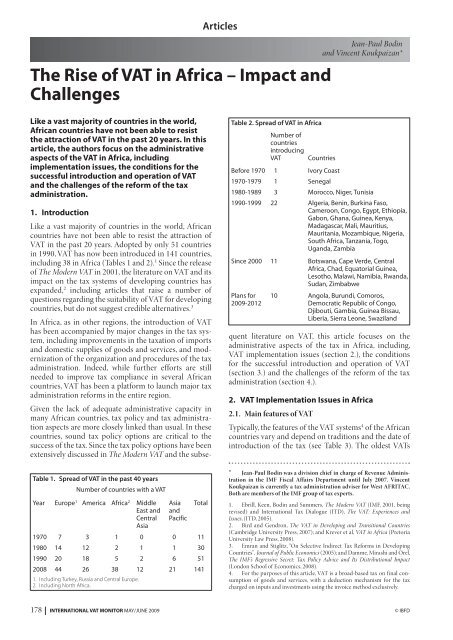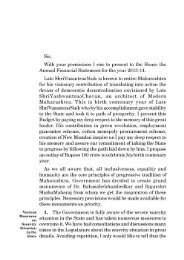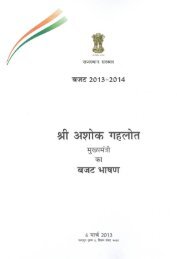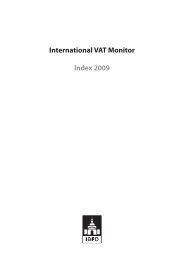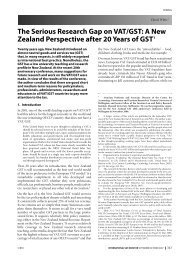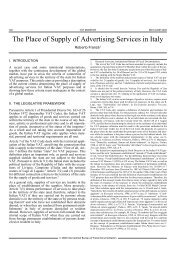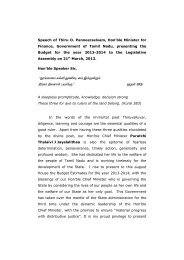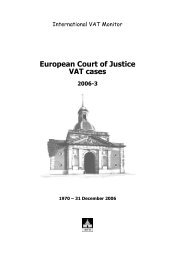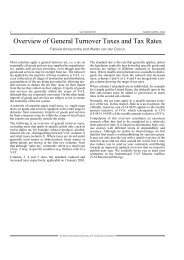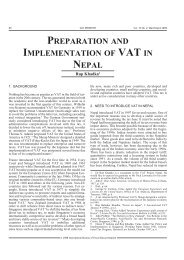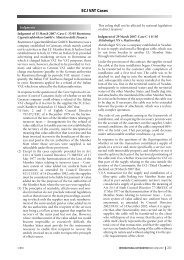The Rise of VAT in Africa – Impact and Challenges - empcom.gov.in
The Rise of VAT in Africa – Impact and Challenges - empcom.gov.in
The Rise of VAT in Africa – Impact and Challenges - empcom.gov.in
You also want an ePaper? Increase the reach of your titles
YUMPU automatically turns print PDFs into web optimized ePapers that Google loves.
Like a vast majority <strong>of</strong> countries <strong>in</strong> the world,<br />
<strong>Africa</strong>n countries have not been able to resist<br />
the attraction <strong>of</strong> <strong>VAT</strong> <strong>in</strong> the past 20 years. In this<br />
article, the authors focus on the adm<strong>in</strong>istrative<br />
aspects <strong>of</strong> the <strong>VAT</strong> <strong>in</strong> <strong>Africa</strong>, <strong>in</strong>clud<strong>in</strong>g<br />
implementation issues, the conditions for the<br />
successful <strong>in</strong>troduction <strong>and</strong> operation <strong>of</strong> <strong>VAT</strong><br />
<strong>and</strong> the challenges <strong>of</strong> the reform <strong>of</strong> the tax<br />
adm<strong>in</strong>istration.<br />
1. Introduction<br />
Like a vast majority <strong>of</strong> countries <strong>in</strong> the world, <strong>Africa</strong>n<br />
countries have not been able to resist the attraction <strong>of</strong><br />
<strong>VAT</strong> <strong>in</strong> the past 20 years. Adopted by only 1 countries<br />
<strong>in</strong> 1990, <strong>VAT</strong> has now been <strong>in</strong>troduced <strong>in</strong> 1 1 countries,<br />
<strong>in</strong>clud<strong>in</strong>g 8 <strong>in</strong> <strong>Africa</strong> (Tables 1 <strong>and</strong> 2). 1 S<strong>in</strong>ce the release<br />
<strong>of</strong> <strong>The</strong> Modern <strong>VAT</strong> <strong>in</strong> 2001, the literature on <strong>VAT</strong> <strong>and</strong> its<br />
impact on the tax systems <strong>of</strong> develop<strong>in</strong>g countries has<br />
exp<strong>and</strong>ed, 2 <strong>in</strong>clud<strong>in</strong>g articles that raise a number <strong>of</strong><br />
questions regard<strong>in</strong>g the suitability <strong>of</strong> <strong>VAT</strong> for develop<strong>in</strong>g<br />
countries, but do not suggest credible alternatives.<br />
In <strong>Africa</strong>, as <strong>in</strong> other regions, the <strong>in</strong>troduction <strong>of</strong> <strong>VAT</strong><br />
has been accompanied by major changes <strong>in</strong> the tax system,<br />
<strong>in</strong>clud<strong>in</strong>g improvements <strong>in</strong> the taxation <strong>of</strong> imports<br />
<strong>and</strong> domestic supplies <strong>of</strong> goods <strong>and</strong> services, <strong>and</strong> modernization<br />
<strong>of</strong> the organization <strong>and</strong> procedures <strong>of</strong> the tax<br />
adm<strong>in</strong>istration. Indeed, while further efforts are still<br />
needed to improve tax compliance <strong>in</strong> several <strong>Africa</strong>n<br />
countries, <strong>VAT</strong> has been a platform to launch major tax<br />
adm<strong>in</strong>istration reforms <strong>in</strong> the entire region.<br />
Given the lack <strong>of</strong> adequate adm<strong>in</strong>istrative capacity <strong>in</strong><br />
many <strong>Africa</strong>n countries, tax policy <strong>and</strong> tax adm<strong>in</strong>istration<br />
aspects are more closely l<strong>in</strong>ked than usual. In these<br />
countries, sound tax policy options are critical to the<br />
success <strong>of</strong> the tax. S<strong>in</strong>ce the tax policy options have been<br />
extensively discussed <strong>in</strong> <strong>The</strong> Modern <strong>VAT</strong> <strong>and</strong> the subse-<br />
Articles<br />
<strong>The</strong> <strong>Rise</strong> <strong>of</strong> <strong>VAT</strong> <strong>in</strong> <strong>Africa</strong> <strong>–</strong> <strong>Impact</strong> <strong>and</strong><br />
<strong>Challenges</strong><br />
Table 1. Spread <strong>of</strong> <strong>VAT</strong> <strong>in</strong> the past 40 years<br />
Number <strong>of</strong> countries with a <strong>VAT</strong><br />
Year Europe 1 America <strong>Africa</strong> 2 Middle<br />
East <strong>and</strong><br />
Central<br />
Asia<br />
Asia<br />
<strong>and</strong><br />
Pacific<br />
Total<br />
1970 7 3 1 0 0 11<br />
1980 14 12 2 1 1 30<br />
1990 20 18 5 2 6 51<br />
2008 44 26 38 12 21 141<br />
1. Includ<strong>in</strong>g Turkey, Russia <strong>and</strong> Central Europe.<br />
2. Includ<strong>in</strong>g North <strong>Africa</strong>.<br />
Table 2. Spread <strong>of</strong> <strong>VAT</strong> <strong>in</strong> <strong>Africa</strong><br />
Number <strong>of</strong><br />
countries<br />
<strong>in</strong>troduc<strong>in</strong>g<br />
<strong>VAT</strong> Countries<br />
Jean-Paul Bod<strong>in</strong><br />
<strong>and</strong> V<strong>in</strong>cent Koukpaizan*<br />
Before 1970 1 Ivory Coast<br />
1970-1979 1 Senegal<br />
1980-1989 3 Morocco, Niger, Tunisia<br />
1990-1999 22 Algeria, Ben<strong>in</strong>, Burk<strong>in</strong>a Faso,<br />
Cameroon, Congo, Egypt, Ethiopia,<br />
Gabon, Ghana, Gu<strong>in</strong>ea, Kenya,<br />
Madagascar, Mali, Mauritius,<br />
Mauritania, Mozambique, Nigeria,<br />
South <strong>Africa</strong>, Tanzania, Togo,<br />
Ug<strong>and</strong>a, Zambia<br />
S<strong>in</strong>ce 2000 11 Botswana, Cape Verde, Central<br />
<strong>Africa</strong>, Chad, Equatorial Gu<strong>in</strong>ea,<br />
Lesotho, Malawi, Namibia, Rw<strong>and</strong>a,<br />
Sudan, Zimbabwe<br />
Plans for<br />
2009-2012<br />
10 Angola, Burundi, Comoros,<br />
Democratic Republic <strong>of</strong> Congo,<br />
Djibouti, Gambia, Gu<strong>in</strong>ea Bissau,<br />
Liberia, Sierra Leone, Swazil<strong>and</strong><br />
quent literature on <strong>VAT</strong>, this article focuses on the<br />
adm<strong>in</strong>istrative aspects <strong>of</strong> the tax <strong>in</strong> <strong>Africa</strong>, <strong>in</strong>clud<strong>in</strong>g,<br />
<strong>VAT</strong> implementation issues (section 2.), the conditions<br />
for the successful <strong>in</strong>troduction <strong>and</strong> operation <strong>of</strong> <strong>VAT</strong><br />
(section .) <strong>and</strong> the challenges <strong>of</strong> the reform <strong>of</strong> the tax<br />
adm<strong>in</strong>istration (section .).<br />
2. <strong>VAT</strong> Implementation Issues <strong>in</strong> <strong>Africa</strong><br />
2.1. Ma<strong>in</strong> features <strong>of</strong> <strong>VAT</strong><br />
Typically, the features <strong>of</strong> the <strong>VAT</strong> systems <strong>of</strong> the <strong>Africa</strong>n<br />
countries vary <strong>and</strong> depend on traditions <strong>and</strong> the date <strong>of</strong><br />
<strong>in</strong>troduction <strong>of</strong> the tax (see Table ). <strong>The</strong> oldest <strong>VAT</strong>s<br />
* Jean-Paul Bod<strong>in</strong> was a division chief <strong>in</strong> charge <strong>of</strong> Revenue Adm<strong>in</strong>istration<br />
<strong>in</strong> the IMF Fiscal Affairs Department until July 2007. V<strong>in</strong>cent<br />
Koukpaizan is currently a tax adm<strong>in</strong>istration adviser for West AFRITAC.<br />
Both are members <strong>of</strong> the IMF group <strong>of</strong> tax experts.<br />
1. Ebrill, Keen, Bod<strong>in</strong> <strong>and</strong> Summers, <strong>The</strong> Modern <strong>VAT</strong> (IMF, 2001, be<strong>in</strong>g<br />
revised) <strong>and</strong> International Tax Dialogue (ITD), <strong>The</strong> <strong>VAT</strong>: Experiences <strong>and</strong><br />
Issues, (ITD, 200 ).<br />
2. Bird <strong>and</strong> Gendron, <strong>The</strong> <strong>VAT</strong> <strong>in</strong> Develop<strong>in</strong>g <strong>and</strong> Transitional Countries<br />
(Cambridge University Press, 2007); <strong>and</strong> Krever et al, <strong>VAT</strong> <strong>in</strong> <strong>Africa</strong> (Pretoria<br />
University Law Press, 2008).<br />
. Emran <strong>and</strong> Stiglitz, “On Selective Indirect Tax Reforms <strong>in</strong> Develop<strong>in</strong>g<br />
Countries”, Journal <strong>of</strong> Public Economics (200 ); <strong>and</strong> Damme, Mirashi <strong>and</strong> Orel,<br />
<strong>The</strong> IMF’s Regressive Secret: Tax Policy Advice <strong>and</strong> Its Distributional <strong>Impact</strong><br />
(London School <strong>of</strong> Economics, 2008).<br />
. For the purposes <strong>of</strong> this article, <strong>VAT</strong> is a broad-based tax on f<strong>in</strong>al consumption<br />
<strong>of</strong> goods <strong>and</strong> services, with a deduction mechanism for the tax<br />
charged on <strong>in</strong>puts <strong>and</strong> <strong>in</strong>vestments us<strong>in</strong>g the <strong>in</strong>voice method exclusively.<br />
178 INTERNATIONAL <strong>VAT</strong> MONITOR MAY/JUNE 2009 © IBFD
Table 3. <strong>VAT</strong> <strong>in</strong> <strong>Africa</strong> <strong>–</strong> ma<strong>in</strong> characteristics (2008)<br />
Country Year <strong>of</strong> adoption Rate(s) Registration threshold<br />
(<strong>in</strong> USD)<br />
Anglophone countries<br />
Botswana 2002 10 40,000 0.45<br />
Egypt 1992 10, 5, 20, 30 27,000 0.34<br />
Ethiopia 2003 15 54,000 0.32<br />
Ghana 1998 12.5 11,000 0.45<br />
Kenya 1990 16 75,000 0.32<br />
Lesotho 2003 14, 5, 15 80,000 0.37<br />
Malawi 2001 17.5 15,000 0.36<br />
Mauritius 1998 15 96,000 0.45<br />
Namibia 2000 15 28,000 0.33<br />
Nigeria 1994 5 0 0.33<br />
Rw<strong>and</strong>a 2001 18 38,000 0.27<br />
South <strong>Africa</strong> 1991 14 42,000 0.46<br />
Sudan 2000 10 50,000 0.13<br />
Tanzania 1998 20 32,000 0.26<br />
Ug<strong>and</strong>a 1996 18 20,000 0.23<br />
Zambia 1995 17.5 50,000 0.38<br />
Zimbabwe 2004 15 2,500 0.64<br />
Hispano/lusophone countries<br />
Cape Verde 2004 15 2,300 0.53<br />
Equatorial Gu<strong>in</strong>ea 2005 15 0 0.25<br />
Mozambique 1999 17 4,000 0.27<br />
Francophone countries<br />
Algeria 1992 17, 7 43,000 0.19<br />
Ben<strong>in</strong> 1991 18 80,000 2 0.35<br />
Burk<strong>in</strong>a Faso 1993 18 60,000 2 0.26<br />
Cameroon 1999 19.3 94,000 0.21<br />
Central <strong>Africa</strong> 2001 18 100,000 2 0.12<br />
Chad 2000 18 56,000 2 0.06<br />
Congo 1997 18.9, 5 36,000 2 0.18<br />
Gabon 1995 18, 10 150,000 2 0.12<br />
Gu<strong>in</strong>ea 1996 18 30,000 2 0.17<br />
Ivory Coast 1960 18 100,000 2 0.25<br />
Madagascar 1994 18 100,000 0.27<br />
Mali 1991 15, 10 60,000 0.45<br />
Mauritania 1995 14 24,000 2 0.38<br />
Morocco 1986 20, 7, 10, 14 200,000 2 0.33<br />
Niger 1986 19 60,000 2 0.09<br />
Senegal 1979 18 100,000 2 0.44<br />
Togo 1995 18 60,000 2 0.09<br />
Tunisia 1988 18, 6, 10, 29 78,000 2 0.34<br />
Efficiency ratio 1<br />
1. <strong>The</strong> ratio <strong>of</strong> <strong>VAT</strong> revenues to GDP divided by the st<strong>and</strong>ard rate <strong>of</strong> <strong>VAT</strong>. A different criterion to assess the efficiency <strong>of</strong> <strong>VAT</strong> is the “C-Efficiency ratio”, which is def<strong>in</strong>ed<br />
≈≈as the ratio <strong>of</strong> the share <strong>of</strong> <strong>VAT</strong> revenues <strong>in</strong> consumption, rather than GDP: see <strong>The</strong> Modern <strong>VAT</strong> (note 1), Chapter IV.<br />
2. Threshold applicable to supplies <strong>of</strong> goods. A different threshold applies to supplies <strong>of</strong> services.<br />
© IBFD INTERNATIONAL <strong>VAT</strong> MONITOR MAY/JUNE 2009<br />
Articles<br />
179
Articles<br />
were adopted <strong>in</strong> the francophone countries, <strong>in</strong>clud<strong>in</strong>g<br />
Ivory Coast, Morocco, Senegal <strong>and</strong> Tunisia. <strong>The</strong>y have a<br />
complex rate structure (three to four rates), different registration<br />
thresholds depend<strong>in</strong>g on activity (for example,<br />
supplies <strong>of</strong> goods <strong>and</strong> provision <strong>of</strong> services), a large<br />
number <strong>of</strong> exemptions (<strong>in</strong>clud<strong>in</strong>g exemption for supplies<br />
to exporters 5 , the achats en franchise), <strong>and</strong> a withhold<strong>in</strong>g<br />
mechanism for supplies to the <strong>gov</strong>ernment <strong>and</strong><br />
state-owned enterprises 6 (see below). S<strong>in</strong>ce the early<br />
1990s, new approaches have been developed to improve<br />
the design <strong>of</strong> <strong>VAT</strong> <strong>in</strong> <strong>Africa</strong>, <strong>in</strong>clud<strong>in</strong>g the adoption <strong>of</strong> a<br />
s<strong>in</strong>gle positive rate for domestic supplies, fewer exemptions,<br />
<strong>and</strong> higher registration thresholds. Such an<br />
approach was <strong>in</strong>itiated <strong>in</strong> Ben<strong>in</strong> <strong>in</strong> 1991 <strong>and</strong>, thereafter,<br />
adopted by the majority <strong>of</strong> <strong>Africa</strong>n countries where <strong>VAT</strong><br />
has been adopted.<br />
As <strong>in</strong> many develop<strong>in</strong>g countries where technical assistance<br />
has been provided, the features <strong>of</strong> the <strong>VAT</strong> have<br />
<strong>of</strong>ten been <strong>in</strong>fluenced by foreign experts. In several<br />
cases, these experts’ advice simply replicated practices<br />
that had been developed <strong>in</strong> their own country. This<br />
expla<strong>in</strong>s, for example, the complex rate <strong>and</strong> threshold<br />
structures, <strong>and</strong> widespread exemptions <strong>in</strong> the “first generation”<br />
<strong>VAT</strong>s that were <strong>in</strong>troduced <strong>in</strong> francophone<br />
countries until the end <strong>of</strong> the 1980s, as well as the very<br />
low registration thresholds <strong>in</strong> hispano <strong>and</strong> lusophone<br />
countries (for example Cape Verde <strong>and</strong> Mozambique),<br />
<strong>and</strong> the uncerta<strong>in</strong>ty regard<strong>in</strong>g the most suitable organization<br />
for <strong>VAT</strong> adm<strong>in</strong>istration <strong>in</strong> most anglophone<br />
countries (for example <strong>in</strong> Malawi, where <strong>VAT</strong> was <strong>in</strong>itially<br />
adm<strong>in</strong>istered by customs <strong>and</strong>, subsequently, by a<br />
<strong>VAT</strong> directorate that was eventually merged with the<br />
<strong>in</strong>come tax adm<strong>in</strong>istration).<br />
In recent years, several countries, for example Algeria,<br />
Ivory Coast <strong>and</strong> Senegal, where old <strong>VAT</strong> systems had<br />
been <strong>in</strong>troduced, have successfully modernized these<br />
systems. However, experience <strong>of</strong> other countries, <strong>in</strong>clud<strong>in</strong>g<br />
Egypt, Morocco <strong>and</strong> Tunisia, shows that moderniz<strong>in</strong>g<br />
a “first generation” <strong>VAT</strong> may politically be more difficult<br />
than adopt<strong>in</strong>g a new <strong>VAT</strong> <strong>in</strong> l<strong>in</strong>e with best practices.<br />
In the second half <strong>of</strong> the 1990s, the <strong>in</strong>itiatives <strong>of</strong> the West<br />
<strong>Africa</strong>n Economic <strong>and</strong> Monetary Union (WAEMU) <strong>and</strong><br />
Central <strong>Africa</strong>n Economic <strong>and</strong> Monetary Community<br />
(CAEMC) to harmonize the <strong>in</strong>direct tax systems <strong>of</strong> their<br />
member countries on the basis <strong>of</strong> recognized best practices<br />
<strong>–</strong> <strong>in</strong>clud<strong>in</strong>g drastic simplification <strong>of</strong> the rate structure,<br />
elim<strong>in</strong>ation <strong>of</strong> several exemptions, an <strong>in</strong>crease <strong>in</strong><br />
the registration threshold, <strong>and</strong> a simplified tax regime for<br />
small bus<strong>in</strong>esses below this threshold <strong>–</strong> have contributed<br />
to the modernization <strong>of</strong> <strong>VAT</strong> <strong>in</strong> West <strong>Africa</strong>. In the com<strong>in</strong>g<br />
years, similar improvements can be expected <strong>in</strong> other<br />
<strong>Africa</strong>n countries, where similar <strong>in</strong>itiatives are be<strong>in</strong>g<br />
taken by the East <strong>Africa</strong>n Community (EAC) or are<br />
be<strong>in</strong>g considered by the Economic Community <strong>of</strong> West<br />
<strong>Africa</strong>n States (ECOWAS) <strong>and</strong> the Southern <strong>Africa</strong>n<br />
Development Community (SADC).<br />
2.2. Ma<strong>in</strong> reasons for the spread <strong>of</strong> <strong>VAT</strong> <strong>in</strong> <strong>Africa</strong><br />
As <strong>in</strong> many other countries, the ma<strong>in</strong> reason for the<br />
spread <strong>of</strong> <strong>VAT</strong> <strong>in</strong> <strong>Africa</strong> was the search for an effective,<br />
neutral tax <strong>in</strong>strument capable <strong>of</strong> meet<strong>in</strong>g revenue<br />
requirements that could not be satisfied by <strong>in</strong>come tax<br />
<strong>and</strong> the traditional turnover tax. In most <strong>Africa</strong>n countries,<br />
<strong>VAT</strong> has replaced complex turnover taxes that were<br />
<strong>in</strong>herited from the colonial era. With a narrow base, multiple<br />
rates <strong>and</strong> complex mechanisms to mitigate their<br />
cascad<strong>in</strong>g effect, these taxes were particularly difficult to<br />
adm<strong>in</strong>ister. 7<br />
<strong>VAT</strong> has also played an important role <strong>in</strong> facilitat<strong>in</strong>g<br />
trade liberalization <strong>and</strong> customs tariff reforms <strong>in</strong><br />
<strong>Africa</strong>n countries that form part <strong>of</strong> regional economic<br />
<strong>and</strong> customs unions (WAEMU <strong>and</strong> CAEMC <strong>in</strong>itially),<br />
<strong>and</strong> those that concluded trade agreements with the<br />
European Union (particularly Morocco <strong>and</strong> Tunisia).<br />
<strong>The</strong> measures adopted to support these <strong>in</strong>itiatives have<br />
contributed to more effective <strong>VAT</strong> <strong>and</strong> excise tax systems<br />
that were capable <strong>of</strong> compensat<strong>in</strong>g the expected<br />
decrease <strong>in</strong> the collection <strong>of</strong> customs duties, <strong>and</strong> cop<strong>in</strong>g<br />
with the challenges <strong>of</strong> the transition from the old tax<br />
regimes. 8<br />
In most <strong>Africa</strong>n countries, the <strong>in</strong>troduction <strong>and</strong> operation<br />
<strong>of</strong> a modern <strong>VAT</strong> <strong>in</strong> l<strong>in</strong>e with best practices has also<br />
provided a better environment for modernization <strong>of</strong> the<br />
entire tax system, beg<strong>in</strong>n<strong>in</strong>g with its adm<strong>in</strong>istration. <strong>The</strong><br />
<strong>in</strong>troduction <strong>of</strong> <strong>VAT</strong> has provided a platform for major<br />
improvements <strong>of</strong> the old tax adm<strong>in</strong>istration systems,<br />
which were <strong>in</strong>herited from the colonial era <strong>and</strong> were<br />
<strong>of</strong>ten characterized by unnecessarily complex <strong>and</strong> outdated<br />
organizational <strong>and</strong> procedural models. 9<br />
2.3. <strong>VAT</strong> adm<strong>in</strong>istration <strong>–</strong> Ma<strong>in</strong> challenges<br />
Contrary to the concerns that were expressed <strong>in</strong> the early<br />
1990s, experience has shown that the <strong>in</strong>troduction <strong>of</strong><br />
<strong>VAT</strong> <strong>in</strong> <strong>Africa</strong> has not resulted <strong>in</strong> major problems, provided<br />
however that the design <strong>of</strong> the tax was <strong>in</strong> l<strong>in</strong>e with<br />
best practices <strong>and</strong> that its <strong>in</strong>troduction was carefully prepared.<br />
10 Except <strong>in</strong> Ghana <strong>and</strong> Ug<strong>and</strong>a (see below), the<br />
<strong>in</strong>troduction <strong>of</strong> <strong>VAT</strong> was generally seen as successful by<br />
. In the francophone countries where the system <strong>of</strong> “achats en franchise”<br />
has been adopted, exports <strong>and</strong> supplies to exporters are usually “exempt” with<br />
a possibility to claim a refund <strong>of</strong> the related <strong>in</strong>put <strong>VAT</strong>, which is equivalent to<br />
a zero rate.<br />
6. Under this system, suppliers <strong>of</strong> goods <strong>and</strong> services charge the full<br />
amount <strong>of</strong> the <strong>VAT</strong> to their customers but, <strong>in</strong>stead <strong>of</strong> pay<strong>in</strong>g the amount <strong>of</strong> the<br />
tax to their suppliers, the customer (“withhold<strong>in</strong>g agent”) withholds this<br />
amount <strong>and</strong> remits it directly to the tax <strong>of</strong>fice (note 12).<br />
7. <strong>The</strong> Modern <strong>VAT</strong> (note 1) provides an analysis <strong>of</strong> the turnover taxes that<br />
were replaced by a <strong>VAT</strong> <strong>in</strong> Ben<strong>in</strong>, Burk<strong>in</strong>a Faso, Gabon, Gu<strong>in</strong>ea, Kenya,<br />
Malawi, Mauritania, Togo, Ug<strong>and</strong>a <strong>and</strong> Zambia.<br />
8. Chambas, “TVA et transition fiscale en Afrique: les nouveaux enjeux”,<br />
Afrique contempora<strong>in</strong>e (200 ).<br />
9. Such models <strong>in</strong>cluded separation <strong>of</strong> the tax assessment <strong>and</strong> collection<br />
functions, which were assigned to two separate directorates <strong>in</strong> the francophone<br />
countries, <strong>and</strong> separation <strong>of</strong> the adm<strong>in</strong>istration <strong>of</strong> direct <strong>and</strong> <strong>in</strong>direct<br />
taxes <strong>in</strong> the anglophone countries.<br />
10. <strong>VAT</strong> preparations have been discussed <strong>in</strong> various documents <strong>in</strong> the early<br />
1990s, <strong>in</strong>clud<strong>in</strong>g the guide that was published <strong>in</strong> 1991, <strong>VAT</strong>: Adm<strong>in</strong>istrative <strong>and</strong><br />
Policy Issues (IMF Occasional Paper).<br />
180 INTERNATIONAL <strong>VAT</strong> MONITOR MAY/JUNE 2009 © IBFD
the bus<strong>in</strong>ess community <strong>and</strong> the tax authorities, who<br />
immediately understood the merits <strong>of</strong> an effective revenue-rais<strong>in</strong>g<br />
<strong>in</strong>strument, which is neutral for economic<br />
activities. In most <strong>Africa</strong>n countries, the <strong>in</strong>troduction <strong>of</strong><br />
<strong>VAT</strong> resulted <strong>in</strong> a quick <strong>in</strong>crease <strong>in</strong> <strong>in</strong>direct tax revenues.<br />
11<br />
Modernization <strong>of</strong> first-generation <strong>VAT</strong>s<br />
Modernization <strong>of</strong> the old <strong>VAT</strong>s to improve their efficiency<br />
is a major challenge <strong>in</strong> several countries (especially<br />
North <strong>Africa</strong>n countries, see Table ). With complex<br />
rate structures, multiple registration thresholds,<br />
pervasive exemptions (<strong>in</strong>clud<strong>in</strong>g those for supplies made<br />
to exporters), <strong>and</strong> withhold<strong>in</strong>g schemes for supplies<br />
made to the <strong>gov</strong>ernment <strong>and</strong> public enterprises (the précompte),<br />
12 these <strong>VAT</strong>s were particularly difficult to<br />
adm<strong>in</strong>ister. <strong>The</strong>se problems have frequently been amplified<br />
by the <strong>in</strong>ability <strong>of</strong> policymakers to resist pressure<br />
from various lobbies request<strong>in</strong>g an extension <strong>of</strong> special<br />
rates or exemptions that were <strong>in</strong>itially reserved for a limited<br />
number <strong>of</strong> cases.<br />
Broaden<strong>in</strong>g the <strong>VAT</strong> base<br />
Broaden<strong>in</strong>g the <strong>VAT</strong> base is a recurrent challenge <strong>in</strong><br />
<strong>Africa</strong>, where a large share (more than half <strong>in</strong> most countries)<br />
<strong>of</strong> the gross <strong>VAT</strong> receipts is collected on imports.<br />
Important sectors, such as the agricultural sector <strong>and</strong><br />
supplies <strong>of</strong> unprocessed foodstuffs, <strong>and</strong> aid-funded projects,<br />
are commonly outside the scope <strong>of</strong> <strong>VAT</strong>. Several<br />
factors contribute to this situation <strong>in</strong> less-advanced<br />
countries, <strong>in</strong>clud<strong>in</strong>g the degree <strong>of</strong> poverty that prevents<br />
taxation <strong>of</strong> unprocessed foodstuffs, the structure <strong>of</strong> economic<br />
activities <strong>and</strong> the small number <strong>of</strong> bus<strong>in</strong>esses<br />
whose turnover is above an adequate <strong>VAT</strong> registration<br />
threshold (a few hundred only <strong>in</strong> the smallest countries).<br />
In this context, broaden<strong>in</strong>g the <strong>VAT</strong> base requires the<br />
development <strong>of</strong> a more effective approach to deal with<br />
the <strong>in</strong>formal sector, keep<strong>in</strong>g <strong>in</strong> m<strong>in</strong>d that, contrary to<br />
some experts’ views, a well-designed <strong>VAT</strong> is capable <strong>of</strong><br />
collect<strong>in</strong>g some tax from this sector (see below).<br />
Improvement <strong>of</strong> <strong>VAT</strong> efficiency<br />
Although, despite a decrease <strong>of</strong> customs duties, the<br />
<strong>in</strong>troduction <strong>of</strong> <strong>VAT</strong> usually results <strong>in</strong> higher <strong>in</strong>direct tax<br />
revenues, it must be recognized that the revenue productivity<br />
<strong>of</strong> <strong>VAT</strong> <strong>in</strong> <strong>Africa</strong> is generally below its potential.<br />
Improvement <strong>of</strong> the <strong>VAT</strong> revenue efficiency is certa<strong>in</strong>ly<br />
a major challenge for several <strong>Africa</strong>n countries where the<br />
tax has been adopted.<br />
<strong>The</strong> ma<strong>in</strong> difficulties <strong>in</strong> the area <strong>of</strong> <strong>VAT</strong> adm<strong>in</strong>istration<br />
typically materialize several years after the <strong>in</strong>troduction<br />
<strong>of</strong> the tax. In <strong>Africa</strong>, as <strong>in</strong> many other develop<strong>in</strong>g countries,<br />
the <strong>VAT</strong> revenue efficiency commonly deteriorates<br />
<strong>in</strong> the medium to long term, if the adm<strong>in</strong>istrative capacity<br />
is <strong>in</strong>sufficient to effectively control claims for refund<br />
<strong>of</strong> excess <strong>in</strong>put <strong>VAT</strong>, <strong>and</strong> to process the exporters’ refund<br />
claims effectively <strong>and</strong> <strong>in</strong> good time. This situation leads<br />
to abusive practices <strong>and</strong> evasion, <strong>and</strong> pressure to exclude<br />
more activities from the <strong>VAT</strong> base. In several <strong>Africa</strong>n<br />
Articles<br />
countries, these difficulties impede the neutrality <strong>of</strong> <strong>VAT</strong><br />
<strong>and</strong> contribute to the low efficiency ratios mentioned<br />
above (Table ), as compared to the ratios <strong>in</strong> other<br />
regions. 1<br />
3. Conditions for Successful Operation <strong>of</strong> <strong>VAT</strong><br />
<strong>The</strong> challenges <strong>of</strong> operat<strong>in</strong>g the <strong>VAT</strong> system have led<br />
several experts to question the wisdom <strong>of</strong> <strong>in</strong>troduc<strong>in</strong>g<br />
<strong>VAT</strong> <strong>in</strong> develop<strong>in</strong>g countries. 1 <strong>The</strong> ma<strong>in</strong> criticism on<br />
the adoption <strong>of</strong> <strong>VAT</strong> <strong>in</strong> <strong>Africa</strong> is based on the follow<strong>in</strong>g:<br />
<strong>–</strong> <strong>VAT</strong> is difficult to adm<strong>in</strong>ister <strong>in</strong> these countries <strong>in</strong><br />
view <strong>of</strong> their <strong>in</strong>adequate adm<strong>in</strong>istrative capacity. For<br />
example, the refund system is too complex for small<br />
entrepreneurs, who are more easily exposed to<br />
<strong>–</strong><br />
harassment by corrupt tax <strong>of</strong>ficers than large bus<strong>in</strong>esses;<br />
record-keep<strong>in</strong>g requirements are too complex <strong>and</strong><br />
tax compliance costs are too high for small bus<strong>in</strong>esses;<br />
<strong>–</strong> due to the high <strong>VAT</strong> compliance costs, many bus<strong>in</strong>ess<br />
owners choose to operate <strong>in</strong> the <strong>in</strong>formal sector;<br />
<strong>and</strong><br />
<strong>–</strong> <strong>VAT</strong> is regressive, especially if a s<strong>in</strong>gle rate is<br />
adopted, as is recommended for a modern <strong>VAT</strong>.<br />
<strong>The</strong>se problems have led some experts 1 to take the view<br />
that <strong>VAT</strong> is not suitable for <strong>Africa</strong>n countries <strong>and</strong> that<br />
trade liberalization measures carried out <strong>in</strong> these countries<br />
s<strong>in</strong>ce the early 1990s were not appropriate. <strong>The</strong>se<br />
experts claim that, as compared to <strong>VAT</strong>, customs duties<br />
are easier to adm<strong>in</strong>ister <strong>and</strong> better deal with the <strong>in</strong>formal<br />
sector. As discussed <strong>in</strong> this section <strong>and</strong> the follow<strong>in</strong>g,<br />
these conclusions are <strong>in</strong> fact a criticism on the <strong>VAT</strong>s that<br />
have been <strong>in</strong>troduced <strong>in</strong> a few <strong>Africa</strong>n countries without<br />
tak<strong>in</strong>g <strong>in</strong>to account the best practices recommended for<br />
successful operation <strong>of</strong> <strong>VAT</strong>. <strong>The</strong> critics also underestimate<br />
the need to modernize the tax <strong>and</strong> customs adm<strong>in</strong>istrations<br />
<strong>in</strong> these countries <strong>and</strong> the changes required to<br />
establish more effective compliance programmes <strong>and</strong><br />
provide better services to taxpayers.<br />
11. <strong>The</strong> Modern <strong>VAT</strong> (note 1). As previously mentioned, <strong>VAT</strong> implementation<br />
has usually been accompanied by measures aimed at simplify<strong>in</strong>g the <strong>in</strong>direct<br />
tax system, <strong>in</strong>clud<strong>in</strong>g repeal<strong>in</strong>g the former consumption taxes, <strong>and</strong><br />
streaml<strong>in</strong><strong>in</strong>g excise taxes (i.e. reduc<strong>in</strong>g the number <strong>of</strong> excisable items) <strong>and</strong> the<br />
customs tariff (i.e. typically, reduc<strong>in</strong>g the number <strong>of</strong> tariff b<strong>and</strong>s <strong>and</strong> the level<br />
<strong>of</strong> the rates). Given that a large share <strong>of</strong> <strong>VAT</strong> revenues is collected on imports,<br />
the revenue impact <strong>of</strong> the adoption <strong>of</strong> a <strong>VAT</strong> must be assessed not only <strong>in</strong> the<br />
light <strong>of</strong> <strong>VAT</strong> efficiency (Table ), but also <strong>in</strong> the light <strong>of</strong> the <strong>in</strong>crease or<br />
decrease <strong>in</strong> the total <strong>in</strong>direct tax collections.<br />
12. In several francophone countries for example, Cameroon, Ivory Coast<br />
<strong>and</strong> Senegal, the amount <strong>of</strong> the <strong>VAT</strong> to be paid on sales to the central <strong>and</strong> local<br />
<strong>gov</strong>ernments is withheld by the Treasury. In other countries, for example,<br />
Kenya <strong>in</strong> <strong>Africa</strong> <strong>and</strong> many countries <strong>in</strong> Lat<strong>in</strong> America, this scheme also applies<br />
to sales to large bus<strong>in</strong>esses that are required to withhold the <strong>VAT</strong> on their purchases<br />
<strong>and</strong> remit it to the tax adm<strong>in</strong>istration. As discussed by Bird <strong>and</strong> Gendron<br />
(note 2), <strong>and</strong> Bod<strong>in</strong> <strong>and</strong> Koukpaizan <strong>in</strong> “Taxation <strong>of</strong> Small Enterprises:<br />
Recent Developments”, International <strong>VAT</strong> Monitor 2 (2008), p. 121, these<br />
schemes have significant drawbacks that underm<strong>in</strong>e the function<strong>in</strong>g <strong>of</strong> the<br />
<strong>VAT</strong>.<br />
1 . <strong>The</strong> average efficiency ratio <strong>in</strong> <strong>Africa</strong> (<strong>in</strong>clud<strong>in</strong>g the North <strong>Africa</strong>n<br />
countries <strong>and</strong> South <strong>Africa</strong>) is 0. 0 aga<strong>in</strong>st 0. 8 <strong>in</strong> Asia (exclud<strong>in</strong>g Australia,<br />
Japan <strong>and</strong> New Zeal<strong>and</strong>) <strong>and</strong> 0. <strong>in</strong> Lat<strong>in</strong> America.<br />
1 . See Damme, Mirashi <strong>and</strong> Orel (note ) <strong>and</strong> Emran <strong>and</strong> Stiglitz (note ).<br />
1 . In particular, Emran <strong>and</strong> Stiglitz (note ).<br />
© IBFD INTERNATIONAL <strong>VAT</strong> MONITOR MAY/JUNE 2009<br />
181
Articles<br />
3.1. Fundamental legislative <strong>and</strong> policy issues<br />
S<strong>in</strong>gle or multiple <strong>VAT</strong> rates<br />
<strong>The</strong> choice <strong>of</strong> the rate structure for domestic supplies 16 is<br />
probably one <strong>of</strong> the most controversial issues s<strong>in</strong>ce the<br />
<strong>in</strong>troduction <strong>of</strong> <strong>VAT</strong> <strong>in</strong> develop<strong>in</strong>g countries. Adoption<br />
<strong>of</strong> a complex rate structure with three, four, or even five<br />
rates was a predom<strong>in</strong>ant feature <strong>of</strong> the first-generation<br />
<strong>VAT</strong>s that were <strong>in</strong>troduced <strong>in</strong> France (19 8-68) <strong>and</strong> <strong>in</strong><br />
several other Member States <strong>of</strong> the European Union (at<br />
the end <strong>of</strong> the 1960s <strong>and</strong> the beg<strong>in</strong>n<strong>in</strong>g <strong>of</strong> the 1970s).<br />
However, s<strong>in</strong>ce the expansion <strong>of</strong> <strong>VAT</strong> to other regions,<br />
<strong>in</strong>clud<strong>in</strong>g <strong>Africa</strong> from the early 1990s, an <strong>in</strong>creas<strong>in</strong>g<br />
number <strong>of</strong> countries have adopted a s<strong>in</strong>gle rate. From the<br />
tax adm<strong>in</strong>istration’s <strong>and</strong> bus<strong>in</strong>ess owners’ perspectives, a<br />
s<strong>in</strong>gle rate is an important factor <strong>in</strong> simplify<strong>in</strong>g the management<br />
<strong>of</strong> <strong>VAT</strong> on the grounds that a s<strong>in</strong>gle rate:<br />
<strong>–</strong> facilitates record keep<strong>in</strong>g <strong>and</strong> <strong>in</strong>voic<strong>in</strong>g. Contrary to<br />
the situation <strong>in</strong> countries with a multiple-rate <strong>VAT</strong>,<br />
there is no need to categorize purchases <strong>and</strong> supplies<br />
<strong>of</strong> goods <strong>and</strong> services <strong>in</strong> accordance with the applicable<br />
rate;<br />
<strong>–</strong> helps simplify the <strong>VAT</strong> declaration form, which can<br />
be limited to a s<strong>in</strong>gle page <strong>and</strong> is easier to complete<br />
by the bus<strong>in</strong>esses <strong>and</strong> to process by the tax adm<strong>in</strong>istration<br />
than a form conta<strong>in</strong><strong>in</strong>g multiple rates;<br />
<strong>–</strong> facilitates “desk verifications“ (for example, reconciliation<br />
<strong>of</strong> <strong>in</strong>formation derived from the <strong>in</strong>come tax<br />
<strong>and</strong> <strong>VAT</strong> returns) <strong>and</strong> <strong>VAT</strong> audits (because the auditors<br />
can focus on check<strong>in</strong>g the accuracy <strong>of</strong> the<br />
reported total supplies <strong>and</strong> expenses, <strong>in</strong>stead <strong>of</strong><br />
check<strong>in</strong>g the distribution <strong>of</strong> these supplies <strong>and</strong><br />
<strong>–</strong><br />
expenses <strong>in</strong> accordance with the applicable rates). A<br />
s<strong>in</strong>gle rate therefore helps reduce the duration <strong>of</strong><br />
audits;<br />
helps avoid the situation <strong>of</strong> permanent excess <strong>in</strong>put<br />
<strong>VAT</strong> for bus<strong>in</strong>esses whose <strong>in</strong>puts are subject to a<br />
higher rate than their outputs. Refund claims can<br />
thus be restricted to exporters <strong>and</strong> <strong>in</strong>vestors.<br />
<strong>The</strong> advantages <strong>of</strong> a s<strong>in</strong>gle rate expla<strong>in</strong> why most countries<br />
where <strong>VAT</strong> was <strong>in</strong>troduced <strong>in</strong> the past 20 years have<br />
opted for a s<strong>in</strong>gle rate. Experience shows that the application<br />
<strong>of</strong> reduced <strong>VAT</strong> rates has no real impact on the<br />
distributional effect <strong>of</strong> the tax system. Recent studies<br />
show that revenue losses due to the adoption <strong>of</strong> reduced<br />
rates benefit ma<strong>in</strong>ly the wealthiest persons, whose consumption,<br />
<strong>in</strong> absolute terms, <strong>of</strong> food <strong>and</strong> other items that<br />
are subject to a reduced rate (such as water <strong>and</strong> electricity)<br />
is higher than that <strong>of</strong> the poor. 17<br />
Despite the obvious benefits <strong>of</strong> a s<strong>in</strong>gle rate, its adoption<br />
is <strong>of</strong>ten difficult for policymakers, who are under pressure<br />
to apply concessions to specific types <strong>of</strong> transactions<br />
or specific sectors. 18 For example, a temporary<br />
<strong>in</strong>crease <strong>in</strong> the price <strong>of</strong> basic foodstuffs <strong>and</strong> raw materials<br />
<strong>in</strong> 2008 has led some countries <strong>in</strong> the WAEMU to<br />
question the rules set by the Commission <strong>of</strong> the<br />
WAEMU <strong>in</strong> the 1990s regard<strong>in</strong>g the m<strong>and</strong>atory adoption<br />
<strong>of</strong> a s<strong>in</strong>gle <strong>VAT</strong> rate. <strong>The</strong> rules have now been<br />
relaxed authoriz<strong>in</strong>g these countries to apply a reduced<br />
rate to specific items. 19 Whatever the legitimate concerns<br />
<strong>of</strong> the supporters <strong>of</strong> multiple rates may be, it is clear that<br />
their approach can significantly <strong>in</strong>crease the complexity<br />
<strong>of</strong> <strong>VAT</strong> <strong>and</strong> may have negative consequences that need to<br />
be carefully assessed <strong>in</strong> countries with a weak adm<strong>in</strong>istrative<br />
capacity. Frequently, these supporters are <strong>of</strong>ten<br />
those who also emphasize the unsuitability <strong>of</strong> <strong>VAT</strong> for<br />
develop<strong>in</strong>g countries, without giv<strong>in</strong>g sufficient thought<br />
to the proper balance between the pros <strong>and</strong> cons <strong>of</strong> their<br />
position.<br />
Broaden<strong>in</strong>g the <strong>VAT</strong> base<br />
Like multiple <strong>VAT</strong> rates, exemptions give rise to complexities.<br />
Exemptions <strong>in</strong>crease the risk <strong>of</strong> cascad<strong>in</strong>g <strong>and</strong><br />
jeopardize the neutrality <strong>of</strong> the <strong>VAT</strong>, which can be particularly<br />
harmful to exports. Exemptions can also give<br />
comparative advantage to imports. Paradoxically, this is<br />
frequently the case for the supply <strong>of</strong> domestically produced<br />
food items, especially <strong>in</strong> less-advanced countries.<br />
20 Another major drawback <strong>of</strong> exemptions is the<br />
risk <strong>of</strong> proliferation (i.e. extension <strong>of</strong> the scope <strong>of</strong> the<br />
exemption to similar items <strong>and</strong> to <strong>in</strong>puts used for the<br />
purposes <strong>of</strong> produc<strong>in</strong>g exempt items). For example,<br />
where supplies <strong>in</strong> the agricultural sector are exempt from<br />
<strong>VAT</strong>, there will be pressure to extend the exemption to<br />
fertilizers. Moreover, as with multiple rates, purchases<br />
<strong>and</strong> supplies <strong>of</strong> exempt goods <strong>and</strong> services must be<br />
recorded separately <strong>and</strong> give rise to complex allocation<br />
rules regard<strong>in</strong>g equipment used for mak<strong>in</strong>g both taxed<br />
<strong>and</strong> exempt supplies. Those complexities can significantly<br />
complicate the bookkeep<strong>in</strong>g <strong>and</strong> fil<strong>in</strong>g obligations<br />
for bus<strong>in</strong>esses. Given their negative impact on the function<strong>in</strong>g<br />
<strong>of</strong> the <strong>VAT</strong>, it is not surpris<strong>in</strong>g that the elim<strong>in</strong>ation<br />
<strong>of</strong> exemptions has become an important issue <strong>in</strong><br />
most <strong>VAT</strong> reforms carried out over the past 20 years. 21<br />
In <strong>Africa</strong>, apart from the traditional exemptions for<br />
social reasons (such as health care <strong>and</strong> education) or<br />
technical reasons (such as f<strong>in</strong>ancial <strong>and</strong> <strong>in</strong>surance transactions,<br />
which may be subject to special schemes), the<br />
ma<strong>in</strong> categories <strong>of</strong> exemptions are the follow<strong>in</strong>g:<br />
16. Only exports be<strong>in</strong>g subject to the zero rate.<br />
17. Bird <strong>and</strong> Gendron (note 2) emphasize the need to take a global approach<br />
<strong>in</strong> assess<strong>in</strong>g the distributional consequences <strong>of</strong> the tax system, Moreover, the<br />
impact <strong>of</strong> the <strong>VAT</strong> threshold must be taken <strong>in</strong>to account. Exempt<strong>in</strong>g small<br />
traders from <strong>VAT</strong> re<strong>in</strong>forces the progressivity <strong>of</strong> the tax system, see Keen,<br />
“What Do (<strong>and</strong> Don’t) We Know about the <strong>VAT</strong>”, International Tax <strong>and</strong> Public<br />
F<strong>in</strong>ance (2008). <strong>The</strong> impact <strong>of</strong> the registration threshold on progressivity is<br />
particularly important if the threshold is set <strong>in</strong> l<strong>in</strong>e with best practices (see<br />
below).<br />
18. <strong>The</strong>se sectors <strong>and</strong> transactions vary, depend<strong>in</strong>g on the circumstances,<br />
from supplies <strong>of</strong> unprocessed foodstuffs to services <strong>in</strong> the tourism sector,<br />
<strong>in</strong>clud<strong>in</strong>g hotel accommodation <strong>and</strong> restaurant transactions, small cars, construction<br />
services, etc.<br />
19. To some extent, the difficulties faced by the WAEMU countries may<br />
have been amplified by the relatively high <strong>VAT</strong> rates <strong>in</strong> francophone <strong>Africa</strong><br />
(<strong>of</strong>ten rang<strong>in</strong>g from 18%-20%, as compared to 12%-1 % <strong>in</strong> many other<br />
<strong>Africa</strong>n countries, see Table ).<br />
20. Another frequent example <strong>in</strong> <strong>Africa</strong> relates to local supplies <strong>of</strong> school<br />
books that bear <strong>VAT</strong> on their <strong>in</strong>puts, while imported books are exempt.<br />
21. <strong>The</strong> ITD (note 1) <strong>and</strong> Chambas (note 8) provide an analysis <strong>of</strong> the drawbacks<br />
<strong>of</strong> exemptions for unprocessed foodstuff <strong>and</strong> their negative impact on<br />
the efficiency <strong>of</strong> <strong>VAT</strong> <strong>in</strong> <strong>Africa</strong>.<br />
182 INTERNATIONAL <strong>VAT</strong> MONITOR MAY/JUNE 2009 © IBFD
<strong>–</strong> agricultural sector <strong>and</strong> supplies <strong>of</strong> unprocessed food<br />
items;<br />
<strong>–</strong> support <strong>of</strong> <strong>in</strong>vestments <strong>and</strong> exports (for example,<br />
exemptions for supplies made to exporters); <strong>and</strong><br />
<strong>–</strong> aid-funded projects.<br />
Despite a few attempts to obta<strong>in</strong> some <strong>VAT</strong> revenue from<br />
the agricultural sector, for example, by elim<strong>in</strong>at<strong>in</strong>g<br />
exemptions for specific agricultural <strong>in</strong>puts, broaden<strong>in</strong>g<br />
the <strong>VAT</strong> base to this sector is likely to be particularly difficult<br />
for a number <strong>of</strong> years. However, depend<strong>in</strong>g on<br />
improvements <strong>in</strong> check<strong>in</strong>g <strong>and</strong> process<strong>in</strong>g claims for<br />
refund <strong>of</strong> excess <strong>in</strong>put <strong>VAT</strong> 22 (see below), a more aggressive<br />
approach should be adopted to elim<strong>in</strong>ate exemptions<br />
relat<strong>in</strong>g to capital goods <strong>and</strong> supplies made to<br />
exporters <strong>and</strong> bus<strong>in</strong>esses <strong>in</strong> export process<strong>in</strong>g zones<br />
(EPZs), as well as supplies relat<strong>in</strong>g to the exploitation <strong>of</strong><br />
natural resources, for example, timber, oil, m<strong>in</strong>erals, etc.<br />
Recent developments regard<strong>in</strong>g the tax treatment <strong>of</strong> aid<br />
could also lead to a gradual elim<strong>in</strong>ation <strong>of</strong> exemptions <strong>in</strong><br />
this area <strong>in</strong> the com<strong>in</strong>g years.<br />
Exemption <strong>of</strong> aid has significant drawbacks, especially,<br />
by def<strong>in</strong>ition, <strong>in</strong> the poorest countries where the adm<strong>in</strong>istrative<br />
capacity is <strong>in</strong>adequate. Special schemes adopted<br />
to control these exemptions, <strong>in</strong>clud<strong>in</strong>g the vouchers systems<br />
developed <strong>in</strong> francophone <strong>Africa</strong>, are complex <strong>and</strong><br />
<strong>in</strong>effective. This is especially true for large aid-funded<br />
projects (such as construction <strong>of</strong> roads, hospitals, etc.),<br />
where <strong>VAT</strong> exemptions on a range <strong>of</strong> goods <strong>and</strong> services<br />
(such as cement, fuel, electricity, cars, equipment, labour<br />
services, etc.), which are imported or purchased on the<br />
local market by various contractors <strong>and</strong> subcontractors,<br />
cannot be effectively controlled by the tax adm<strong>in</strong>istration.<br />
This expla<strong>in</strong>s why the World Bank <strong>and</strong> other<br />
donors, such as the Inter-American Development Bank<br />
<strong>and</strong> the Asian Development Bank, have recently<br />
reviewed their approach <strong>and</strong> accepted that aid-funded<br />
projects should <strong>in</strong> pr<strong>in</strong>ciple be subject to <strong>VAT</strong>. 2<br />
Modernization <strong>and</strong> simplification <strong>of</strong> the tax law, <strong>in</strong>clud<strong>in</strong>g<br />
broaden<strong>in</strong>g the <strong>VAT</strong> base <strong>and</strong> elim<strong>in</strong>at<strong>in</strong>g exemptions<br />
<strong>and</strong> reduced rates, are <strong>of</strong>ten tough decisions for<br />
policymakers. To facilitate these decisions, several countries<br />
have developed tax expenditure analyses to help<br />
underst<strong>and</strong> the negative consequences <strong>of</strong> exemptions<br />
<strong>and</strong> reduced rates. Initially, these systems were <strong>in</strong>troduced<br />
<strong>in</strong> OECD countries. In recent years, they have also<br />
been used by a few other countries <strong>in</strong> <strong>Africa</strong> (for example<br />
Morocco s<strong>in</strong>ce 2006 <strong>and</strong>, more recently, Algeria). <strong>The</strong><br />
<strong>in</strong>itial results <strong>of</strong> this approach are encourag<strong>in</strong>g. 2<br />
3.2. <strong>VAT</strong> registration threshold <strong>and</strong> treatment <strong>of</strong> small<br />
bus<strong>in</strong>esses<br />
Adoption <strong>of</strong> a sufficiently high threshold is a critical prerequisite<br />
for successful operation <strong>of</strong> <strong>VAT</strong> <strong>in</strong> countries<br />
with an <strong>in</strong>adequate adm<strong>in</strong>istrative capacity. 2 In the<br />
absence <strong>of</strong> a clear picture <strong>of</strong> the distribution <strong>of</strong> bus<strong>in</strong>esses<br />
by level <strong>of</strong> turnover, <strong>and</strong> a good underst<strong>and</strong><strong>in</strong>g <strong>of</strong><br />
the distribution <strong>of</strong> the value added among the various<br />
sectors <strong>of</strong> the economy based on the size <strong>of</strong> the bus<strong>in</strong>esses,<br />
policymakers <strong>and</strong> experts, who have ignored this<br />
Articles<br />
basic prerequisite, have encountered problems when<br />
<strong>VAT</strong> was <strong>in</strong>troduced <strong>in</strong> some countries.<br />
<strong>The</strong> need for a sufficiently high registration threshold<br />
<strong>The</strong> cases <strong>of</strong> Ghana <strong>and</strong> Ug<strong>and</strong>a, where the <strong>in</strong>troduction<br />
<strong>of</strong> <strong>VAT</strong> <strong>in</strong> 199 <strong>and</strong> 1996 resulted <strong>in</strong> serious problems,<br />
<strong>in</strong>clud<strong>in</strong>g demonstrations <strong>and</strong> riots, are still remembered<br />
by a number <strong>of</strong> tax specialists <strong>in</strong> <strong>Africa</strong>. <strong>The</strong> lack <strong>of</strong><br />
a sufficiently high registration threshold was identified<br />
as the ma<strong>in</strong> reason for these difficulties <strong>in</strong> both countries.<br />
Despite their weak adm<strong>in</strong>istrative capacity, the tax<br />
<strong>of</strong>fices attempted to register a large number <strong>of</strong> small<br />
bus<strong>in</strong>esses, who had very little underst<strong>and</strong><strong>in</strong>g <strong>of</strong> the<br />
requirements for, <strong>and</strong> function<strong>in</strong>g <strong>of</strong>, the <strong>VAT</strong> system. In<br />
Ug<strong>and</strong>a, the decision <strong>of</strong> the authorities to immediately<br />
<strong>in</strong>crease the registration threshold was sufficient to<br />
ensure that <strong>VAT</strong> was quickly on track. However, <strong>in</strong><br />
Ghana, the magnitude <strong>of</strong> the resistance aga<strong>in</strong>st <strong>VAT</strong> led<br />
the <strong>gov</strong>ernment to abolish the <strong>VAT</strong> law, which was re<strong>in</strong>troduced<br />
<strong>in</strong> 1999, with a significantly higher threshold. 26<br />
Until the second half <strong>of</strong> the 1990s, contrary to the francophone<br />
countries with a tradition <strong>of</strong> high registration<br />
thresholds that were regularly adapted to <strong>in</strong>flation, <strong>VAT</strong><br />
was <strong>in</strong>troduced <strong>in</strong> most other <strong>Africa</strong>n countries with relatively<br />
low thresholds. Except for the well-known case <strong>of</strong><br />
the lusophone countries, most <strong>Africa</strong>n countries 27 have<br />
learned the lessons from the experience <strong>of</strong> Ghana <strong>and</strong><br />
Ug<strong>and</strong>a.<br />
<strong>The</strong> lusophone countries have been used as an example<br />
by the experts who question the wisdom <strong>of</strong> <strong>in</strong>troduc<strong>in</strong>g<br />
<strong>VAT</strong> <strong>in</strong> <strong>Africa</strong>. <strong>The</strong>ir criticism is ma<strong>in</strong>ly based on the difficulties<br />
faced by small bus<strong>in</strong>esses <strong>in</strong> comply<strong>in</strong>g with the<br />
<strong>VAT</strong> requirements, <strong>in</strong>clud<strong>in</strong>g:<br />
<strong>–</strong> high tax compliance costs <strong>and</strong> the difficulties for,<br />
sometimes illiterate, small bus<strong>in</strong>ess owners <strong>in</strong> ma<strong>in</strong>ta<strong>in</strong><strong>in</strong>g<br />
proper books <strong>and</strong> records;<br />
<strong>–</strong> risks <strong>of</strong> harassment <strong>of</strong> these small taxpayers by tax<br />
<strong>of</strong>ficials; <strong>and</strong><br />
<strong>–</strong> eventually, the <strong>in</strong>centive for small bus<strong>in</strong>esses to<br />
operate <strong>in</strong> the <strong>in</strong>formal sector. 28<br />
Introduction <strong>of</strong> <strong>VAT</strong> <strong>in</strong> a country with a large <strong>in</strong>formal<br />
sector undoubtedly requires comprehensive <strong>and</strong> careful<br />
22. In many develop<strong>in</strong>g countries, the difficulties faced by <strong>in</strong>vestors <strong>and</strong><br />
exporters <strong>in</strong> obta<strong>in</strong><strong>in</strong>g their <strong>VAT</strong> refunds are among the ma<strong>in</strong> reasons why<br />
<strong>VAT</strong> exemptions are <strong>of</strong>ten widespread.<br />
2 . <strong>The</strong>se issues <strong>and</strong> their consequences for donors <strong>and</strong> develop<strong>in</strong>g countries<br />
have been discussed by the International Tax Dialogue: Tax Treatment <strong>of</strong><br />
Donor-F<strong>in</strong>anced Projects (ITD, 2006).<br />
2 . S<strong>in</strong>ce the release <strong>of</strong> the first tax expenditure analysis <strong>in</strong> Morocco, several<br />
<strong>VAT</strong> exemptions have been repealed <strong>and</strong> a step-by-step approach to phase out<br />
reduced <strong>VAT</strong> rates has been developed.<br />
2 . <strong>The</strong> Modern <strong>VAT</strong> (note 1), <strong>and</strong> Keen <strong>and</strong> M<strong>in</strong>tz, “<strong>The</strong> optimal threshold<br />
for a <strong>VAT</strong>”, Journal <strong>of</strong> Public Economics (200 ).<br />
26. Terkper,“<strong>VAT</strong> <strong>in</strong> Ghana: Why it Failed”, Tax Notes International (1996).<br />
27. Includ<strong>in</strong>g those where <strong>VAT</strong> was <strong>in</strong>troduced <strong>in</strong> the mid-1990s (such<br />
as Lesotho <strong>and</strong> Mauritius) <strong>and</strong> the countries where the threshold was significantly<br />
<strong>in</strong>creased <strong>in</strong> recent years (such as Kenya).<br />
28. See Damme, Mirashi, <strong>and</strong> Orel (note ) <strong>and</strong> the problems faced by small<br />
bus<strong>in</strong>esses <strong>in</strong> Mozambique <strong>in</strong> comply<strong>in</strong>g with their <strong>VAT</strong> obligations. In an<br />
attempt to address these problems, a simplified <strong>VAT</strong> scheme was adopted <strong>in</strong><br />
that country, <strong>in</strong> addition to another simplified system for <strong>in</strong>come tax.<br />
© IBFD INTERNATIONAL <strong>VAT</strong> MONITOR MAY/JUNE 2009<br />
18
Articles<br />
preparation. A key issue to be addressed dur<strong>in</strong>g these<br />
preparations is the establishment <strong>of</strong> a sufficiently high<br />
registration threshold to address the difficulties mentioned<br />
above. Box 1 provides a brief analysis <strong>of</strong> the consequences<br />
<strong>of</strong> <strong>VAT</strong> <strong>in</strong> an economy with a large <strong>in</strong>formal<br />
sector. 29<br />
Box 1. <strong>VAT</strong> <strong>and</strong> the <strong>in</strong>formal sector<br />
Experience shows that a modern <strong>VAT</strong> is a tool that is at least<br />
equivalent, if not superior, to customs duties <strong>and</strong> traditional<br />
turnover taxes <strong>in</strong> countries with a large <strong>in</strong>formal sector. If<br />
appropriately designed, <strong>VAT</strong> helps creat<strong>in</strong>g an environment<br />
that takes <strong>in</strong>to account the needs <strong>of</strong> small bus<strong>in</strong>esses <strong>and</strong><br />
encourages other bus<strong>in</strong>esses to operate <strong>in</strong> the formal sector,<br />
while ensur<strong>in</strong>g that operators <strong>in</strong> the <strong>in</strong>formal sector contribute,<br />
to some extent, to the tax revenues.<br />
Small bus<strong>in</strong>esses<br />
Adopt<strong>in</strong>g a high <strong>VAT</strong> registration threshold is a significant<br />
first step towards simplify<strong>in</strong>g the tax <strong>and</strong> account<strong>in</strong>g requirements<br />
for small <strong>and</strong> micro bus<strong>in</strong>esses <strong>and</strong> reduc<strong>in</strong>g their<br />
<strong>in</strong>centive to operate <strong>in</strong> the <strong>in</strong>formal sector. Application <strong>of</strong> a<br />
high registration threshold has very little impact on total <strong>VAT</strong><br />
revenues because the loss <strong>of</strong> tax revenue is limited to the tax<br />
on the marg<strong>in</strong> <strong>of</strong> small retailers. 30 Conversely, adoption <strong>of</strong> a<br />
high registration threshold is not possible <strong>in</strong> a traditional<br />
turnover tax system (especially a retail sales tax) because <strong>of</strong><br />
the obvious risks <strong>of</strong> revenue losses.<br />
Bus<strong>in</strong>esses <strong>in</strong> the formal sector<br />
<strong>The</strong> credit mechanism is an <strong>in</strong>centive for the bus<strong>in</strong>esses <strong>in</strong><br />
the formal sector to select suppliers who are registered for<br />
<strong>VAT</strong>. That mechanism may also be an encouragement for<br />
small bus<strong>in</strong>esses, whose turnover is below the registration<br />
threshold, to register on a voluntary basis <strong>in</strong> order to <strong>in</strong>crease<br />
their supplies to registered bus<strong>in</strong>esses. 31<br />
Informal operators<br />
Contrary to the conclusions <strong>of</strong> those who criticize the simplification<br />
<strong>and</strong> decrease <strong>of</strong> customs duties <strong>and</strong> the repeal <strong>of</strong> the<br />
old turnover taxes, experience shows that <strong>VAT</strong> is a more<br />
appropriate tool <strong>in</strong> an environment with a large <strong>in</strong>formal sector.<br />
<strong>VAT</strong> is just as effective as customs duties as a means to tax<br />
imports <strong>of</strong> goods <strong>and</strong> capital equipment. Moreover, import<br />
<strong>VAT</strong> is deductible from the <strong>VAT</strong> due on the supplies <strong>of</strong> registered<br />
importers, but is a cost for importers operat<strong>in</strong>g <strong>in</strong> the<br />
<strong>in</strong>formal sector. <strong>VAT</strong> is therefore an effective means <strong>of</strong> collect<strong>in</strong>g<br />
at least some tax from <strong>in</strong>formal operators, beg<strong>in</strong>n<strong>in</strong>g with<br />
<strong>VAT</strong> on their imports. 32 In the same manner, these operators<br />
also contribute to the tax revenue because they cannot<br />
deduct the <strong>VAT</strong> <strong>in</strong>curred on their domestic purchases <strong>of</strong><br />
goods <strong>and</strong> services (such as electricity, water, telephone<br />
services, cars, gas, cement, etc.).<br />
<strong>VAT</strong> registration threshold <strong>–</strong> best practices<br />
In <strong>Africa</strong>, depend<strong>in</strong>g on the country’s history, three ma<strong>in</strong><br />
trends can be identified regard<strong>in</strong>g the <strong>VAT</strong> registration<br />
thresholds:<br />
<strong>–</strong> very low thresholds <strong>in</strong> hispano <strong>and</strong> lusophone countries;<br />
<strong>–</strong> moderate thresholds <strong>in</strong> anglophone countries; <strong>and</strong><br />
<strong>–</strong> high thresholds for supplies <strong>of</strong> goods <strong>and</strong> lower<br />
thresholds for services <strong>in</strong> the francophone countries<br />
(see Table ).<br />
In most <strong>of</strong> these countries, the <strong>VAT</strong> registration threshold<br />
is the predom<strong>in</strong>ant criterion to def<strong>in</strong>e small bus<strong>in</strong>esses.<br />
By structur<strong>in</strong>g the total population <strong>of</strong> bus<strong>in</strong>esses<br />
on the basis <strong>of</strong> turnover <strong>–</strong> whether the level is set below<br />
or above the threshold <strong>–</strong> the <strong>VAT</strong> provides a good framework<br />
to develop important tax adm<strong>in</strong>istration concepts,<br />
<strong>in</strong>clud<strong>in</strong>g the exemption <strong>of</strong> small bus<strong>in</strong>esses <strong>and</strong> a simplified<br />
tax regime for these bus<strong>in</strong>esses.<br />
Based on a recent comparative study, the best practice<br />
regard<strong>in</strong>g the adoption <strong>of</strong> a <strong>VAT</strong> threshold would be the<br />
follow<strong>in</strong>g:<br />
<strong>–</strong> adoption <strong>of</strong> a sufficiently high threshold, for example<br />
<strong>in</strong> the range <strong>of</strong> the equivalent <strong>of</strong> USD 60,000 to<br />
100,000;<br />
<strong>–</strong> harmonization <strong>of</strong> the taxation pr<strong>in</strong>ciples applicable<br />
to small bus<strong>in</strong>esses for <strong>VAT</strong> <strong>and</strong> <strong>in</strong>come tax;<br />
<strong>–</strong> adoption <strong>of</strong> a s<strong>in</strong>gle threshold for supplies <strong>of</strong> goods<br />
<strong>and</strong> the provision <strong>of</strong> services (because dist<strong>in</strong>guish<strong>in</strong>g<br />
supplies <strong>of</strong> goods from services is <strong>of</strong>ten difficult<br />
for small bus<strong>in</strong>esses <strong>and</strong> leads to complex <strong>and</strong> arbitrary<br />
regulations); <strong>and</strong><br />
<strong>–</strong> elim<strong>in</strong>ation <strong>of</strong> discrim<strong>in</strong>ation based on corporate<br />
structure by also apply<strong>in</strong>g the <strong>VAT</strong> threshold to<br />
small corporate bus<strong>in</strong>esses (because this type <strong>of</strong> discrim<strong>in</strong>ation<br />
is now history for a grow<strong>in</strong>g number <strong>of</strong><br />
bus<strong>in</strong>esses).<br />
Taxation <strong>of</strong> small <strong>and</strong> micro bus<strong>in</strong>esses<br />
Although discussion <strong>of</strong> the need to establish special tax<br />
regimes for small <strong>and</strong> micro bus<strong>in</strong>esses is certa<strong>in</strong>ly not<br />
new, this topic has received greater attention <strong>in</strong> recent<br />
years from tax adm<strong>in</strong>istrators <strong>and</strong> policymakers <strong>in</strong> many<br />
countries, <strong>in</strong>clud<strong>in</strong>g those <strong>of</strong> the OECD <strong>and</strong> a number <strong>of</strong><br />
develop<strong>in</strong>g countries. To a large extent, the relatively<br />
high costs born by small <strong>and</strong> micro bus<strong>in</strong>esses to comply<br />
with the st<strong>and</strong>ard requirements <strong>of</strong> the tax system <strong>and</strong> the<br />
costs <strong>of</strong> the tax adm<strong>in</strong>istration to enforce these requirements<br />
for this large group <strong>of</strong> taxpayers expla<strong>in</strong> the grow<strong>in</strong>g<br />
<strong>in</strong>terest <strong>in</strong> this topic. Taxation <strong>of</strong> small bus<strong>in</strong>esses has<br />
become an important component <strong>of</strong> the tax reform pro-<br />
29. On these issues <strong>and</strong> the response to the criticism <strong>of</strong> Emran <strong>and</strong> Stiglitz<br />
(note ), see Keen, “<strong>VAT</strong> Attacks! Second Best Perspectives on <strong>VAT</strong>”, International<br />
Tax <strong>and</strong> Public F<strong>in</strong>ance (2007).<br />
0. In fact, experience shows that an <strong>in</strong>crease <strong>in</strong> the threshold most <strong>of</strong>ten<br />
helps <strong>in</strong>crease the effectiveness <strong>of</strong> the tax adm<strong>in</strong>istration <strong>and</strong> the revenue performance<br />
<strong>of</strong> the <strong>VAT</strong>.<br />
1. In most <strong>VAT</strong> systems, the option for voluntary registration is open to<br />
small bus<strong>in</strong>esses that are able to keep proper books <strong>and</strong> records, issue <strong>in</strong>voices,<br />
<strong>and</strong> have a good tax compliance history.<br />
2. See Keen (notes 17 <strong>and</strong> 29). To <strong>in</strong>crease the contribution <strong>of</strong> <strong>in</strong>formal<br />
operators to the tax revenues, several <strong>Africa</strong>n countries also apply an advance<br />
<strong>in</strong>come tax that is collected by customs on imports. This advance payment is<br />
creditable aga<strong>in</strong>st the f<strong>in</strong>al <strong>in</strong>come tax liabilities <strong>of</strong> the bus<strong>in</strong>esses <strong>in</strong> the formal<br />
sector. It is therefore a cost for the bus<strong>in</strong>esses <strong>in</strong> the <strong>in</strong>formal economy <strong>and</strong><br />
those who do not comply with their tax obligations.<br />
. Bod<strong>in</strong> <strong>and</strong> Koukpaizan (note 12).<br />
. Similarly, harmonized pr<strong>in</strong>ciples also apply to small bus<strong>in</strong>esses that voluntarily<br />
register for <strong>VAT</strong>. <strong>The</strong>se small bus<strong>in</strong>esses must also opt for the normal<br />
tax <strong>and</strong> account<strong>in</strong>g regimes for <strong>in</strong>come tax.<br />
. After the first conference on <strong>VAT</strong> <strong>in</strong> March 200 , the organizations promot<strong>in</strong>g<br />
the International Tax Dialogue (ITD) have naturally focused their<br />
work on small-bus<strong>in</strong>ess taxation dur<strong>in</strong>g the second conference that was held<br />
<strong>in</strong> October 2007, (www.itdweb.org/SMEconference).<br />
18 INTERNATIONAL <strong>VAT</strong> MONITOR MAY/JUNE 2009 © IBFD
grammes developed <strong>in</strong> <strong>Africa</strong>: design<strong>in</strong>g an appropriate<br />
tax regime for small <strong>and</strong> micro bus<strong>in</strong>esses is a necessary<br />
step towards facilitat<strong>in</strong>g the modernization <strong>of</strong> the <strong>VAT</strong><br />
system <strong>and</strong> the adoption <strong>of</strong> a high registration threshold.<br />
<strong>The</strong> comparative study <strong>of</strong> the tax systems for small bus<strong>in</strong>esses<br />
shows a great diversity <strong>of</strong> the exist<strong>in</strong>g regimes,<br />
<strong>in</strong>clud<strong>in</strong>g: turnover taxes, patents, systems based on<br />
physical <strong>in</strong>dicators, taxes based on the bus<strong>in</strong>ess’ rental<br />
value, etc. 6 Discussion <strong>and</strong> the exchange <strong>of</strong> views on this<br />
topic are relatively new. <strong>The</strong> discussions dur<strong>in</strong>g the ITD<br />
conference confirm that there is not yet a credible guide<br />
to best practices. While an <strong>in</strong>-depth evaluation <strong>of</strong> the<br />
exist<strong>in</strong>g regimes is needed, those recently developed <strong>in</strong><br />
some countries should be given particular attention, for<br />
example, the tax regime for small bus<strong>in</strong>esses that was<br />
<strong>in</strong>troduced <strong>in</strong> Madagascar <strong>in</strong> 2008. 7<br />
4. Reform <strong>of</strong> Tax Adm<strong>in</strong>istration <strong>–</strong> Progress <strong>and</strong><br />
<strong>Challenges</strong><br />
4.1. <strong>Impact</strong> <strong>of</strong> <strong>VAT</strong> on tax adm<strong>in</strong>istration<br />
<strong>VAT</strong> is certa<strong>in</strong>ly the most important tax reform that has<br />
taken place <strong>in</strong> <strong>Africa</strong> <strong>in</strong> the past 20 years <strong>and</strong> it is not surpris<strong>in</strong>g<br />
that its <strong>in</strong>troduction has resulted <strong>in</strong> significant<br />
changes for most tax adm<strong>in</strong>istrations <strong>in</strong> this region. <strong>The</strong><br />
experts who question the appropriateness <strong>of</strong> <strong>VAT</strong> for<br />
develop<strong>in</strong>g countries sometimes claim that similar<br />
changes could have been made under the previous tax<br />
systems, <strong>in</strong>clud<strong>in</strong>g the old turnover taxes. To a large<br />
extent, these views reflect a lack <strong>of</strong> experience with the<br />
actual situation <strong>of</strong> the tax <strong>and</strong> customs adm<strong>in</strong>istrations<br />
<strong>in</strong> <strong>Africa</strong>.<br />
<strong>The</strong> collection procedures for <strong>in</strong>come tax that were <strong>in</strong><br />
place prior to the <strong>in</strong>troduction <strong>of</strong> <strong>VAT</strong> were primarily<br />
based on negotiations between tax <strong>of</strong>ficers <strong>and</strong> taxpayers.<br />
8 <strong>The</strong>se procedures were particularly <strong>in</strong>effective <strong>and</strong><br />
time consum<strong>in</strong>g. <strong>The</strong>y also provided significant opportunities<br />
for corruption. Similarly, the old turnover taxes<br />
were particularly complex <strong>and</strong> difficult to adm<strong>in</strong>ister. In<br />
several countries, they were supplemented by specific<br />
excise taxes on numerous items (sometimes more than<br />
20, such as gold, tea, sugar, cement, soap, etc). <strong>The</strong> adm<strong>in</strong>istration<br />
<strong>of</strong> these taxes was commonly based on physical<br />
controls similar to those used by the customs adm<strong>in</strong>istration.<br />
<strong>The</strong>se controls provided opportunities for multiple<br />
visits to the taxpayer’s premises, which were frequently<br />
accompanied by harassment <strong>and</strong> corruption. All<br />
tax adm<strong>in</strong>istration specialists who have provided technical<br />
assistance <strong>in</strong> <strong>Africa</strong>n countries before the <strong>in</strong>troduction<br />
<strong>of</strong> <strong>VAT</strong> can confirm that it was impossible to<br />
develop a sound tax adm<strong>in</strong>istration modernization<br />
strategy <strong>in</strong> such a context.<br />
Modernization <strong>of</strong> the tax adm<strong>in</strong>istration has <strong>of</strong>ten<br />
started with develop<strong>in</strong>g more effective <strong>and</strong> transparent<br />
collection methods for <strong>VAT</strong>. It has also frequently<br />
<strong>in</strong>volved a fundamental change <strong>in</strong> the organizational<br />
structure <strong>of</strong> the tax adm<strong>in</strong>istration, especially <strong>in</strong>tegration<br />
<strong>of</strong> functions that were previously fragmented<br />
among several agencies. Another component <strong>of</strong> the<br />
Articles<br />
modernization, which has also been significantly <strong>in</strong>fluenced<br />
by the “structur<strong>in</strong>g effect” <strong>of</strong> <strong>VAT</strong>, is the development<br />
<strong>of</strong> the concept <strong>of</strong> “segmentation” <strong>of</strong> taxpayers. This<br />
concept takes <strong>in</strong>to account the characteristics <strong>of</strong> the various<br />
categories <strong>of</strong> taxpayers, <strong>in</strong> order to adapt the compliance<br />
programmes <strong>and</strong> the network <strong>of</strong> local <strong>of</strong>fices to<br />
the need <strong>of</strong> the taxpayers for specific services, <strong>and</strong> to the<br />
different types <strong>of</strong> risks <strong>of</strong> non-compliance (see below). 9<br />
When <strong>and</strong> how have these reforms started <strong>in</strong> <strong>Africa</strong>? In<br />
several countries, substantial procedural <strong>and</strong> organizational<br />
reforms were <strong>in</strong>itiated dur<strong>in</strong>g the preparatory<br />
stage <strong>of</strong> the <strong>in</strong>troduction <strong>of</strong> <strong>VAT</strong>. This was, for example,<br />
the case regard<strong>in</strong>g the transfer <strong>of</strong> the collection function<br />
from the Treasury to the tax adm<strong>in</strong>istration <strong>and</strong> the<br />
establishment <strong>of</strong> the first large-taxpayers <strong>of</strong>fices to facilitate<br />
the <strong>in</strong>troduction <strong>of</strong> <strong>VAT</strong> <strong>in</strong> francophone <strong>Africa</strong> (for<br />
example, <strong>in</strong> Ben<strong>in</strong> <strong>in</strong> 1990 <strong>and</strong> <strong>in</strong> Togo <strong>in</strong> 199 ). To some<br />
extent, the creation <strong>of</strong> semi-autonomous revenue agencies<br />
(the “revenue authorities”) <strong>in</strong> anglophone <strong>Africa</strong> <strong>in</strong><br />
the 1990s was also part <strong>of</strong> the plans that were developed<br />
for the <strong>in</strong>troduction <strong>of</strong> <strong>VAT</strong> (for example <strong>in</strong> Tanzania,<br />
Ug<strong>and</strong>a <strong>and</strong> Zambia).<br />
Moreover, significant steps, such as the development <strong>of</strong><br />
taxpayer identification number systems, new fil<strong>in</strong>g <strong>and</strong><br />
payment methods, <strong>and</strong> new education <strong>and</strong> <strong>in</strong>formation<br />
programmes, were also developed <strong>in</strong> several countries<br />
dur<strong>in</strong>g the preparations for the <strong>in</strong>troduction <strong>of</strong> <strong>VAT</strong>, on<br />
the basis <strong>of</strong> the available guides <strong>of</strong> best practices. 0 However,<br />
<strong>in</strong> most <strong>Africa</strong>n countries, <strong>in</strong>clud<strong>in</strong>g those where<br />
prelim<strong>in</strong>ary steps had been taken prior to the <strong>in</strong>troduction<br />
<strong>of</strong> <strong>VAT</strong> or as part <strong>of</strong> the preparatory process, the<br />
most fundamental reforms <strong>of</strong> the tax adm<strong>in</strong>istration<br />
were made after this <strong>in</strong>troduction.<br />
4.2. Modernization <strong>of</strong> the method <strong>of</strong> taxation<br />
<strong>VAT</strong> is basically a self-assessed, account-based tax. Its<br />
<strong>in</strong>troduction has led to significant changes <strong>in</strong> the<br />
method <strong>of</strong> taxation. <strong>The</strong> fil<strong>in</strong>g <strong>and</strong> payment regimes that<br />
6. Bod<strong>in</strong> <strong>and</strong> Koukpaizan (note 12), <strong>and</strong> Marquez, Bareix <strong>and</strong> Villela, Recommendations<br />
<strong>and</strong> Best Practices on Taxation <strong>of</strong> SMEs <strong>in</strong> Lat<strong>in</strong> America, (Inter-<br />
American Development Bank, 200 ).<br />
7. This regime was developed for small <strong>and</strong> micro bus<strong>in</strong>esses with a<br />
turnover below the <strong>VAT</strong> registration threshold (approximately USD 100,000).<br />
Small bus<strong>in</strong>esses, which are def<strong>in</strong>ed as those with a turnover between USD<br />
10,000 <strong>and</strong> the <strong>VAT</strong> threshold, are subject to a simplified (cash flow) <strong>in</strong>come<br />
tax. Micro bus<strong>in</strong>esses, which are def<strong>in</strong>ed as those with a turnover below USD<br />
10,000, are subject to a presumptive tax based on the turnover. A similar<br />
regime was also developed <strong>in</strong> Egypt <strong>in</strong> 2006, but it is unclear if a firm decision<br />
has been made to launch it.<br />
8. In anglophone <strong>Africa</strong>, these procedures were based on “adm<strong>in</strong>istrative<br />
assessment.” <strong>The</strong>y provided for the verification <strong>of</strong> all returns prior to f<strong>in</strong>alization<br />
<strong>of</strong> the assessment <strong>and</strong> payment <strong>of</strong> the <strong>in</strong>come tax due (<strong>of</strong>ten several years<br />
after the return had been submitted). A similar concept (enrôlement) was also<br />
used <strong>in</strong> several francophone countries, where the taxation process was further<br />
complicated by the fragmentation <strong>of</strong> the assessment <strong>and</strong> collection functions<br />
between two directorates report<strong>in</strong>g separately to the M<strong>in</strong>ister <strong>of</strong> F<strong>in</strong>ance.<br />
9. Taxpayer segmentation is an application <strong>of</strong> a basic market<strong>in</strong>g concept<br />
(market segmentation) to identify the unique characteristics <strong>of</strong> different<br />
groups <strong>of</strong> clients <strong>and</strong> design a market<strong>in</strong>g strategy that is based on these characteristics.<br />
<strong>The</strong>oretically, this concept could have been developed from a<br />
review <strong>of</strong> <strong>in</strong>come tax data. However, these data were particularly poor <strong>and</strong><br />
<strong>in</strong>accurate <strong>in</strong> most <strong>Africa</strong>n countries.<br />
0. In particular, <strong>VAT</strong>: Adm<strong>in</strong>istrative <strong>and</strong> Policy Issues (IMF, 1991).<br />
© IBFD INTERNATIONAL <strong>VAT</strong> MONITOR MAY/JUNE 2009<br />
18
Articles<br />
are developed for <strong>VAT</strong> (generally monthly, at least for the<br />
largest bus<strong>in</strong>esses) require the development <strong>of</strong> procedures<br />
that are cost effective from the perspectives <strong>of</strong><br />
both the taxpayer <strong>and</strong> the tax adm<strong>in</strong>istration. <strong>The</strong><br />
adm<strong>in</strong>istrative assessment system that was used for<br />
<strong>in</strong>come tax <strong>and</strong> the physical controls for the old consumption<br />
taxes were clearly <strong>in</strong>appropriate for <strong>VAT</strong>.<br />
Despite the <strong>in</strong>itial resistance <strong>and</strong> difficulties <strong>in</strong> some<br />
countries, self-assessment procedures based on voluntary<br />
compliance have been adopted for <strong>VAT</strong>.<br />
Under a self-assessment system, taxpayers are expected<br />
to comply with their basic tax obligations with only limited<br />
<strong>in</strong>tervention <strong>of</strong> tax <strong>of</strong>ficials. With access to advice<br />
from the tax adm<strong>in</strong>istration, taxpayers must calculate<br />
their own tax liabilities; complete their tax returns; submit<br />
returns <strong>and</strong> make the necessary payments to the tax<br />
adm<strong>in</strong>istration; <strong>and</strong> be prepared to justify their declaration,<br />
if selected for audit. 1 <strong>The</strong>se procedures help<br />
<strong>in</strong>crease the effectiveness <strong>and</strong> efficiency <strong>of</strong> tax <strong>of</strong>ficers,<br />
who can concentrate on the detection <strong>and</strong> appropriate<br />
treatment <strong>of</strong> non-compliance. To provide better services<br />
to taxpayers, several countries, such as Nigeria, Rw<strong>and</strong>a,<br />
Tanzania <strong>and</strong> Ug<strong>and</strong>a, have also developed collection<br />
systems through the banks. More recently, electronic fil<strong>in</strong>g<br />
<strong>and</strong> payment procedures have also been <strong>in</strong>itiated <strong>in</strong><br />
countries such as Mauritius, Morocco, South <strong>Africa</strong> <strong>and</strong><br />
Tunisia. <strong>The</strong>se <strong>in</strong>itiatives, which are now common practice<br />
<strong>in</strong> other regions, are still at a prelim<strong>in</strong>ary stage <strong>in</strong><br />
<strong>Africa</strong>, but further progress can be expected <strong>in</strong> the com<strong>in</strong>g<br />
years.<br />
Implementation <strong>of</strong> these procedures should be facilitated<br />
by the development <strong>of</strong> new <strong>in</strong>formation technology<br />
(IT) systems, which is still <strong>in</strong> an early stage <strong>in</strong> most<br />
<strong>Africa</strong>n countries. After major failures <strong>in</strong> the 1990s, a<br />
second generation <strong>of</strong> IT systems is be<strong>in</strong>g developed s<strong>in</strong>ce<br />
the early 2000s <strong>in</strong> a few countries (such as Egypt,<br />
Rw<strong>and</strong>a <strong>and</strong> Ug<strong>and</strong>a) that have been able to prepare<br />
comprehensive tax adm<strong>in</strong>istration modernization projects<br />
with the support <strong>of</strong> donors. 2 However, progress <strong>in</strong><br />
this area is still fragile <strong>and</strong> development <strong>of</strong> IT systems<br />
capable <strong>of</strong> effectively support<strong>in</strong>g the work <strong>of</strong> the tax<br />
<strong>of</strong>fices is still essentially limited to the large-taxpayer<br />
<strong>of</strong>fices <strong>in</strong> most <strong>Africa</strong>n countries.<br />
Despite the need for more effective IT support, selfassessment<br />
helps reduce the compliance costs for the<br />
taxpayers <strong>and</strong> the need for personal contact with tax<br />
<strong>of</strong>ficers, which also helps reduce opportunities for collusion.<br />
<strong>The</strong> new procedures that were <strong>in</strong>itially designed for<br />
<strong>VAT</strong> now apply to most taxes, <strong>in</strong>clud<strong>in</strong>g personal <strong>and</strong><br />
corporate <strong>in</strong>come taxes, <strong>in</strong> most countries. <strong>The</strong> organization<br />
<strong>of</strong> the key functions needed to support selfassessment<br />
<strong>and</strong> the design <strong>of</strong> strategies to implement<br />
these functions are now at the core <strong>of</strong> the reform programmes<br />
<strong>of</strong> these adm<strong>in</strong>istrations.<br />
4.3. Modernization <strong>of</strong> the organizational structure <strong>of</strong><br />
the tax adm<strong>in</strong>istration<br />
<strong>The</strong> organizational structure <strong>of</strong> most tax adm<strong>in</strong>istrations<br />
<strong>in</strong> <strong>Africa</strong> has been <strong>in</strong>fluenced by the pr<strong>in</strong>ciples<br />
<strong>in</strong>herited from the colonial era as well as the technical<br />
advice provided by foreign experts, which is <strong>of</strong>ten based<br />
on tax adm<strong>in</strong>istration practices <strong>in</strong> their own countries.<br />
Thus, until recently, a common characteristic <strong>in</strong> the<br />
anglophone <strong>and</strong> francophone countries was the fragmentation<br />
<strong>of</strong> the tax adm<strong>in</strong>istration responsibilities<br />
between separate organizations:<br />
<strong>–</strong> one organization responsible for <strong>in</strong>come tax <strong>and</strong><br />
another for customs, <strong>VAT</strong> <strong>and</strong> excise duties <strong>in</strong> the<br />
anglophone countries; <strong>and</strong><br />
<strong>–</strong> one organization <strong>in</strong> charge <strong>of</strong> most tax adm<strong>in</strong>istration<br />
functions <strong>and</strong> another responsible for the collection<br />
<strong>of</strong> taxes (sometimes all taxes, sometimes only<br />
direct taxes) <strong>in</strong> the francophone countries.<br />
Integration <strong>of</strong> all ma<strong>in</strong> functions<br />
<strong>The</strong> fragmentation <strong>of</strong> functions results <strong>in</strong> duplication<br />
<strong>and</strong> unnecessary complexity for taxpayers, who must<br />
deal with separate agencies to comply with their tax obligations.<br />
It has also a significant negative effect on the<br />
cost <strong>of</strong> tax adm<strong>in</strong>istration <strong>and</strong> results <strong>in</strong> unnecessary<br />
coord<strong>in</strong>ation problems that impede tax compliance. In<br />
francophone <strong>Africa</strong>, the separation <strong>of</strong> assessment <strong>and</strong><br />
collection functions had a number <strong>of</strong> drawbacks <strong>and</strong> was<br />
not compatible with the self-assessment procedure.<br />
Experience has proved that coord<strong>in</strong>ation problems<br />
between two agencies, which were <strong>of</strong>ten reluctant to<br />
share <strong>in</strong>formation, were a significant impediment to the<br />
<strong>in</strong>dispensable quick action needed aga<strong>in</strong>st non-compliant<br />
taxpayers.<br />
Similar coord<strong>in</strong>ation problems, <strong>in</strong>clud<strong>in</strong>g the use <strong>of</strong> different<br />
taxpayer identification numbers, also had a significant<br />
negative effect on compliance with <strong>in</strong>come tax <strong>and</strong><br />
<strong>VAT</strong> obligations <strong>in</strong> the anglophone countries. <strong>VAT</strong> is<br />
essentially an account-based tax <strong>and</strong> its control necessitates<br />
a crosscheck<strong>in</strong>g <strong>of</strong> basic data (purchases, supplies<br />
<strong>and</strong> <strong>in</strong>vestments) that is also used for the <strong>in</strong>come tax.<br />
This expla<strong>in</strong>s why <strong>in</strong>tegration <strong>of</strong> the most important tax<br />
adm<strong>in</strong>istration functions <strong>in</strong>to a unified agency, <strong>and</strong> the<br />
merger <strong>of</strong> <strong>VAT</strong> <strong>and</strong> <strong>in</strong>come tax data <strong>and</strong> returns with<strong>in</strong> a<br />
s<strong>in</strong>gle file are now seen as best practices <strong>in</strong> a vast majority<br />
<strong>of</strong> countries. As shown <strong>in</strong> Box 2, the <strong>in</strong>troduction <strong>of</strong><br />
<strong>VAT</strong> <strong>in</strong> <strong>Africa</strong> over the past 20 years has led to modernization<br />
<strong>of</strong> the organizational structure <strong>of</strong> the tax adm<strong>in</strong>istration<br />
by merg<strong>in</strong>g key functions (<strong>in</strong>clud<strong>in</strong>g assessment<br />
<strong>and</strong> collection) for the ma<strong>in</strong> domestic taxes<br />
(<strong>in</strong>clud<strong>in</strong>g <strong>VAT</strong>, excise taxes <strong>and</strong> <strong>in</strong>come tax) with<strong>in</strong> a<br />
unified, function-based organization.<br />
1. <strong>The</strong> Modern <strong>VAT</strong> (note 1) <strong>and</strong> ITD (note 1).<br />
2. <strong>The</strong>se projects are be<strong>in</strong>g supported by the United States (USAID) <strong>and</strong><br />
United K<strong>in</strong>gdom (DFID) technical assistance programmes.<br />
. Ironically, the United K<strong>in</strong>gdom <strong>and</strong> France have f<strong>in</strong>ally followed the<br />
approach <strong>of</strong> their former colonies by end<strong>in</strong>g the fragmentation <strong>of</strong> their revenue<br />
adm<strong>in</strong>istrations <strong>in</strong> 200 <strong>and</strong> 2008, respectively. <strong>The</strong> ambitious l<strong>in</strong>es<br />
taken <strong>in</strong> each country may however raise further questions as to the efficiency<br />
<strong>of</strong> the:<br />
<strong>–</strong> merger <strong>of</strong> <strong>in</strong>come tax, <strong>VAT</strong> <strong>and</strong> excise tax operations <strong>in</strong>to a s<strong>in</strong>gle agency<br />
deal<strong>in</strong>g also with border control <strong>in</strong> the United K<strong>in</strong>gdom; <strong>and</strong><br />
<strong>–</strong> merger <strong>of</strong> tax adm<strong>in</strong>istration <strong>and</strong> public expenditures management<br />
with<strong>in</strong> a new Direction générale des f<strong>in</strong>ances publiques (DGFIP) <strong>in</strong> France,<br />
186 INTERNATIONAL <strong>VAT</strong> MONITOR MAY/JUNE 2009 © IBFD
Segmentation <strong>of</strong> taxpayers<br />
<strong>The</strong> <strong>VAT</strong> facilitates the development <strong>of</strong> a more structured<br />
picture <strong>of</strong> the taxpayer population, beg<strong>in</strong>n<strong>in</strong>g with<br />
categorization <strong>of</strong> bus<strong>in</strong>esses depend<strong>in</strong>g on their annual<br />
turnover (i.e. above or below the <strong>VAT</strong> registration<br />
threshold). Indeed, <strong>in</strong> many countries, especially <strong>in</strong><br />
<strong>Africa</strong>, the <strong>in</strong>troduction <strong>of</strong> <strong>VAT</strong> has helped to develop a<br />
better underst<strong>and</strong><strong>in</strong>g <strong>of</strong> the “segmentation” <strong>of</strong> bus<strong>in</strong>esses<br />
(i.e. their classification by size <strong>and</strong> turnover).<br />
Box 2. Modernization <strong>of</strong> the organization <strong>of</strong> tax adm<strong>in</strong>istration<br />
<strong>in</strong> <strong>Africa</strong>n countries<br />
In a vast majority <strong>of</strong> <strong>Africa</strong>n countries, adm<strong>in</strong>istration <strong>of</strong> <strong>VAT</strong><br />
was simply assigned to the domestic tax adm<strong>in</strong>istration<br />
when the <strong>VAT</strong> law was adopted. 44 However, <strong>in</strong> some cases,<br />
especially <strong>in</strong> the anglophone <strong>and</strong> francophone countries, the<br />
<strong>in</strong>troduction <strong>of</strong> <strong>VAT</strong> led to major changes <strong>in</strong> the organizational<br />
structure <strong>of</strong> the tax adm<strong>in</strong>istration.<br />
Several francophone countries dealt with the separation <strong>of</strong><br />
the collection <strong>and</strong> assessment functions45 by adopt<strong>in</strong>g special<br />
rules for <strong>VAT</strong>. This was the case <strong>in</strong> Ivory Coast <strong>and</strong> Senegal,<br />
where, like <strong>in</strong> France, <strong>VAT</strong> collection was assigned to the general<br />
tax directorate when the new tax was <strong>in</strong>troduced. Other<br />
francophone countries followed a more drastic approach by<br />
transferr<strong>in</strong>g all tax collection functions to the tax adm<strong>in</strong>istration<br />
<strong>in</strong> the preparatory stage <strong>of</strong> the <strong>in</strong>troduction <strong>of</strong> <strong>VAT</strong> (for<br />
example <strong>in</strong> Ben<strong>in</strong> <strong>and</strong> Togo <strong>in</strong> the early 1990s) or several<br />
years after its <strong>in</strong>troduction (for example <strong>in</strong> Mauritania <strong>and</strong><br />
Morocco <strong>in</strong> the early 2000s).<br />
In the anglophone countries, the hesitations regard<strong>in</strong>g the<br />
most appropriate agency to adm<strong>in</strong>ister <strong>VAT</strong> were an echo <strong>of</strong><br />
the particular situation <strong>in</strong> the United K<strong>in</strong>gdom, where the<br />
adm<strong>in</strong>istration <strong>of</strong> <strong>in</strong>direct taxes had been assigned to customs<br />
<strong>of</strong>ficers due to the special circumstances <strong>in</strong> the 1940s. 46<br />
However, after experience had proved that this model was<br />
not appropriate for develop<strong>in</strong>g countries (such as Pakistan<br />
<strong>and</strong> Malawi, where it became quickly obvious that the pr<strong>of</strong>ile<br />
<strong>and</strong> tra<strong>in</strong><strong>in</strong>g <strong>of</strong> customs <strong>of</strong>ficers were not suitable for the<br />
adm<strong>in</strong>istration <strong>of</strong> domestic <strong>VAT</strong>), most anglophone countries<br />
have created a new revenue directorate to adm<strong>in</strong>ister <strong>VAT</strong>.<br />
This separation was not questioned when semi-autonomous<br />
revenue agencies were established <strong>in</strong> these countries <strong>in</strong> the<br />
1990s, despite a few <strong>in</strong>itiatives to improve the coord<strong>in</strong>ation<br />
<strong>of</strong> the <strong>VAT</strong> <strong>and</strong> <strong>in</strong>come tax directorates, <strong>and</strong> the development<br />
<strong>of</strong> common human resources <strong>and</strong> support functions. However,<br />
s<strong>in</strong>ce early 2000, the majority <strong>of</strong> the anglophone countries<br />
<strong>in</strong> <strong>Africa</strong> (<strong>in</strong>clud<strong>in</strong>g Egypt, Kenya, Malawi, Rw<strong>and</strong>a, Tanzania,<br />
Ug<strong>and</strong>a <strong>and</strong> Zambia) have embarked on a major<br />
restructur<strong>in</strong>g <strong>of</strong> their domestic tax adm<strong>in</strong>istrations. In these<br />
countries, the adm<strong>in</strong>istration <strong>of</strong> <strong>VAT</strong> <strong>and</strong> <strong>in</strong>come tax has<br />
eventually been merged <strong>in</strong>to a unified, function-based tax<br />
directorate.<br />
<strong>The</strong> concept <strong>of</strong> segmentation <strong>of</strong> taxpayers is a key component<br />
<strong>of</strong> the strategies to modernize the tax adm<strong>in</strong>istration<br />
that have been developed s<strong>in</strong>ce the second half <strong>of</strong><br />
the 1990s. <strong>The</strong> rationale for organiz<strong>in</strong>g tax adm<strong>in</strong>istration<br />
on the basis <strong>of</strong> specific categories <strong>of</strong> taxpayers<br />
enables this adm<strong>in</strong>istration to develop a compliance<br />
strategy that <strong>in</strong>cludes the proper balance <strong>of</strong> service <strong>and</strong><br />
enforcement programmes that are needed to take <strong>in</strong>to<br />
account the particular risks <strong>and</strong> needs <strong>of</strong> each group.<br />
After the creation <strong>of</strong> special units to adm<strong>in</strong>ister the tax<br />
affairs <strong>of</strong> large bus<strong>in</strong>esses, establishment <strong>of</strong> dedicated<br />
<strong>of</strong>fices <strong>and</strong> special programmes for medium-sized busi-<br />
Articles<br />
nesses <strong>and</strong> for small <strong>and</strong> micro bus<strong>in</strong>esses is <strong>of</strong>ten seen<br />
as an essential step towards moderniz<strong>in</strong>g the tax adm<strong>in</strong>istration.<br />
7<br />
<strong>The</strong> segmentation <strong>of</strong> taxpayers facilitates a better underst<strong>and</strong><strong>in</strong>g<br />
<strong>of</strong> the respective needs <strong>of</strong> large, medium-sized<br />
<strong>and</strong> small bus<strong>in</strong>esses <strong>in</strong> order to develop <strong>and</strong> provide<br />
appropriate services <strong>and</strong> education programmes. It also<br />
facilitates a better knowledge <strong>of</strong> the compliance risks<br />
<strong>and</strong>, therefore, the development <strong>of</strong> specific enforcement<br />
programmes to cope with these risks. In recent years, this<br />
type <strong>of</strong> organization was <strong>in</strong>troduced <strong>in</strong> several <strong>Africa</strong>n<br />
countries, <strong>in</strong>clud<strong>in</strong>g Algeria, Ben<strong>in</strong>, Egypt, Malawi,<br />
Rw<strong>and</strong>a, Sudan <strong>and</strong> Ug<strong>and</strong>a.<br />
4.4. Audit <strong>and</strong> <strong>VAT</strong> refund issues<br />
Tax audit issues<br />
An effective audit programme is an essential component<br />
<strong>of</strong> a tax system that is based on self-assessment. Experience<br />
<strong>of</strong> most <strong>Africa</strong>n countries where self-assessment<br />
has been <strong>in</strong>troduced <strong>in</strong> the past 20 years, shows that<br />
implementation <strong>of</strong> an audit programme is still a major<br />
challenge. Several factors contribute to this situation,<br />
<strong>in</strong>clud<strong>in</strong>g difficulties <strong>in</strong> recruit<strong>in</strong>g <strong>and</strong> reta<strong>in</strong><strong>in</strong>g qualified<br />
auditors, <strong>and</strong> the concern that a too aggressive audit<br />
programme can result <strong>in</strong> taxpayer harassment. 8 <strong>The</strong>se<br />
problems can be particularly acute <strong>in</strong> countries where<br />
the tax adm<strong>in</strong>istration is not able to pay an adequate<br />
salary to auditors.<br />
on the basis <strong>of</strong> a model similar to the one that was implemented <strong>in</strong> the<br />
Ottoman Empire <strong>and</strong> the countries that had been <strong>in</strong>fluenced by this model<br />
until recently (for example, Afghanistan, Lebanon, Romania <strong>and</strong> Syria).<br />
. <strong>The</strong> adm<strong>in</strong>istration <strong>of</strong> <strong>VAT</strong> was assigned to the domestic tax adm<strong>in</strong>istration<br />
<strong>in</strong> more than 90% <strong>of</strong> the countries where <strong>VAT</strong> was <strong>in</strong>troduced, see <strong>The</strong><br />
Modern <strong>VAT</strong> (note 1).<br />
. Separation <strong>of</strong> the collection <strong>and</strong> assessment functions was not compatible<br />
with the development <strong>of</strong> the <strong>VAT</strong>’s collection method based on self-assessment.<br />
It was based on the famous pr<strong>in</strong>ciple <strong>of</strong> “séparation des ordonnateurs et<br />
des comptables”, which was developed <strong>in</strong> France at the beg<strong>in</strong>n<strong>in</strong>g <strong>of</strong> the last<br />
century.<br />
6. <strong>The</strong> <strong>gov</strong>ernment decided to assign the adm<strong>in</strong>istration <strong>of</strong> the consumption<br />
tax <strong>and</strong> excises to the customs <strong>of</strong>fices dur<strong>in</strong>g the Second World War<br />
because the customs <strong>of</strong>ficers did not have much work dur<strong>in</strong>g that period.<br />
7. <strong>The</strong> most common classification <strong>of</strong> bus<strong>in</strong>esses <strong>in</strong> many <strong>Africa</strong>n countries<br />
is the follow<strong>in</strong>g:<br />
<strong>–</strong> small bus<strong>in</strong>esses whose turnover is below the <strong>VAT</strong> registration threshold;<br />
<strong>–</strong> medium-sized bus<strong>in</strong>esses whose turnover is above the registration<br />
threshold but who do not have the characteristics <strong>of</strong> a “large bus<strong>in</strong>ess”;<br />
<strong>and</strong><br />
<strong>–</strong> large bus<strong>in</strong>esses (that are now typically adm<strong>in</strong>istered by a large taxpayer<br />
<strong>of</strong>fice).<br />
<strong>The</strong> fundamental characteristic <strong>of</strong> small <strong>and</strong> micro bus<strong>in</strong>esses is that they represent<br />
the vast majority <strong>of</strong> all bus<strong>in</strong>esses (<strong>of</strong>ten from 80% to 90%), regardless<br />
<strong>of</strong> their corporate structure, while the tax revenue generated by their activities<br />
represents only a small portion <strong>of</strong> the total tax revenues (less than %<strong>–</strong>10% <strong>in</strong><br />
many countries). Conversely, the large bus<strong>in</strong>esses represent less than 1% <strong>of</strong> all<br />
bus<strong>in</strong>esses <strong>and</strong> frequently generate more than 70% <strong>of</strong> total tax revenues.<br />
Between these extremes, medium-sized bus<strong>in</strong>esses <strong>of</strong>ten represent 10<strong>–</strong>20% <strong>of</strong><br />
all taxpayers <strong>and</strong> frequently generate 20%<strong>–</strong>2 % <strong>of</strong> total tax revenues. This distribution<br />
must <strong>of</strong> course be ref<strong>in</strong>ed depend<strong>in</strong>g on the circumstances. Given<br />
the differences <strong>in</strong> the tax base among countries accord<strong>in</strong>g to their level <strong>of</strong><br />
development, the concept <strong>of</strong> bus<strong>in</strong>ess size is relative <strong>and</strong> the distribution <strong>of</strong><br />
micro, small, medium-sized <strong>and</strong> large bus<strong>in</strong>esses may vary significantly, see<br />
Bod<strong>in</strong> <strong>and</strong> Koukpaizan (note 12).<br />
8. <strong>The</strong> Modern <strong>VAT</strong> (note 1) <strong>and</strong> <strong>The</strong> <strong>VAT</strong>: Experiences <strong>and</strong> Issues (note 1).<br />
© IBFD INTERNATIONAL <strong>VAT</strong> MONITOR MAY/JUNE 2009<br />
187
Articles<br />
Moreover, the lack <strong>of</strong> an effective audit programme is<br />
<strong>of</strong>ten the result <strong>of</strong> a weak political commitment <strong>and</strong><br />
<strong>in</strong>adequate support provided to the tax adm<strong>in</strong>istration.<br />
It can also be expla<strong>in</strong>ed, <strong>in</strong> many <strong>Africa</strong>n countries, by<br />
the lack <strong>of</strong> an adequate legal <strong>and</strong> judicial framework to<br />
protect the taxpayers’ rights, while ensur<strong>in</strong>g that tax evasion<br />
is effectively dealt with. This situation has a number<br />
<strong>of</strong> drawbacks, beg<strong>in</strong>n<strong>in</strong>g with the risk <strong>of</strong> non-compliance<br />
<strong>and</strong> underreport<strong>in</strong>g <strong>of</strong> the taxes due. <strong>The</strong>se risks are<br />
not limited to <strong>VAT</strong>, but they contribute to its <strong>in</strong>adequate<br />
efficiency <strong>and</strong> to the problems faced by exporters <strong>and</strong><br />
<strong>in</strong>vestors <strong>in</strong> order to receive prompt payment <strong>of</strong> their<br />
excess <strong>in</strong>put <strong>VAT</strong>.<br />
Aga<strong>in</strong>st this background, two positive aspects <strong>of</strong> a <strong>VAT</strong><br />
audit programme must however be emphasized. <strong>The</strong><br />
first is the relative simplicity <strong>of</strong> <strong>VAT</strong> audits as compared<br />
to audits for corporate or personal <strong>in</strong>come tax or compared<br />
to comprehensive audits for the purposes <strong>of</strong> establish<strong>in</strong>g<br />
the taxpayer’s total tax liabilities. Although the<br />
skills required for <strong>VAT</strong> audits have some similarity with<br />
those required for the other types <strong>of</strong> audits, they are significantly<br />
less sophisticated. 9 <strong>The</strong> second positive aspect<br />
is the potential impact <strong>of</strong> an effective audit programme,<br />
<strong>in</strong>clud<strong>in</strong>g a well-designed <strong>VAT</strong> audit component, 0 on<br />
<strong>in</strong>come tax compliance <strong>in</strong> a unified tax adm<strong>in</strong>istration,<br />
where <strong>VAT</strong> <strong>and</strong> <strong>in</strong>come tax data are <strong>in</strong>cluded <strong>in</strong> a s<strong>in</strong>gle<br />
file for each <strong>in</strong>dividual taxpayer.<br />
Process<strong>in</strong>g <strong>of</strong> <strong>VAT</strong> refunds<br />
Recent studies provid<strong>in</strong>g <strong>in</strong>formation on the level <strong>of</strong><br />
<strong>VAT</strong> refunds <strong>and</strong> current practices <strong>in</strong> this area (<strong>in</strong>clud<strong>in</strong>g<br />
refund procedures, process<strong>in</strong>g delays, approaches<br />
developed to deal with the risks <strong>of</strong> fraud, etc.) have<br />
resulted <strong>in</strong> a classification <strong>of</strong> the <strong>VAT</strong> systems <strong>of</strong> certa<strong>in</strong><br />
regions <strong>and</strong> countries. 1 <strong>The</strong>se studies confirm the difficulties<br />
faced by most <strong>Africa</strong>n tax adm<strong>in</strong>istrations <strong>in</strong><br />
mak<strong>in</strong>g refunds <strong>of</strong> excess <strong>in</strong>put <strong>VAT</strong> to legitimate<br />
exporters. <strong>The</strong> level <strong>of</strong> refunds (as compared to total<br />
gross <strong>VAT</strong> receipts) was less than 10% <strong>in</strong> <strong>Africa</strong> <strong>in</strong> 1998-<br />
2001, aga<strong>in</strong>st % <strong>in</strong> the OECD countries <strong>and</strong> 17% <strong>in</strong><br />
Lat<strong>in</strong> America <strong>in</strong> the same period.<br />
While the level <strong>of</strong> refunds is largely dependent on external<br />
factors, such as the degree <strong>of</strong> development <strong>and</strong> openness<br />
<strong>of</strong> the economy, a review <strong>of</strong> the refund practices <strong>in</strong><br />
<strong>Africa</strong> shows that there is room for significant improvement<br />
<strong>in</strong> most countries. <strong>The</strong> most frequent shortcom<strong>in</strong>gs<br />
<strong>in</strong> these countries are the follow<strong>in</strong>g:<br />
<strong>–</strong> lengthy refund procedures. Refunds are sometimes<br />
delayed by more than a year;<br />
<strong>–</strong> unnecessarily complex procedures, <strong>in</strong>clud<strong>in</strong>g, for<br />
example, the requirement to attach copies <strong>of</strong> previous<br />
<strong>VAT</strong> returns, purchase <strong>and</strong> sales <strong>in</strong>voices, <strong>and</strong><br />
import declarations to the refund application form;<br />
<strong>–</strong> lack <strong>of</strong> basic tools <strong>and</strong> methods to assess the risks,<br />
beg<strong>in</strong>n<strong>in</strong>g with a basic dist<strong>in</strong>ction between refund<br />
claims made by legitimate exporters with a good<br />
compliance history <strong>and</strong> other claims; <strong>and</strong><br />
<strong>–</strong> due to the lack <strong>of</strong> basic risk analysis, all <strong>VAT</strong> refund<br />
claims are systematically subject to audit.<br />
<strong>The</strong> complex procedures <strong>and</strong> excessive delays <strong>in</strong> process<strong>in</strong>g<br />
refund claims made by legitimate exporters<br />
expla<strong>in</strong> why it is difficult to elim<strong>in</strong>ate undesirable practices<br />
<strong>and</strong> features <strong>of</strong> the <strong>VAT</strong> system that contribute to<br />
the poor effectiveness <strong>and</strong> efficiency <strong>of</strong> the tax adm<strong>in</strong>istration,<br />
<strong>in</strong>clud<strong>in</strong>g exemption for <strong>in</strong>vestments <strong>and</strong> transactions<br />
<strong>in</strong> the EPZ, systematic <strong>VAT</strong> exemption for the<br />
exploitation <strong>of</strong> natural resources <strong>and</strong> for supplies made<br />
to exporters (achats en franchises) <strong>in</strong> several francophone<br />
countries.<br />
Adoption <strong>of</strong> a high threshold is the first measure to<br />
address the criticisms <strong>of</strong> experts who stress the complexity<br />
<strong>of</strong> the refund procedures for small bus<strong>in</strong>esses.<br />
Another important step is the limitation <strong>of</strong> the refunds<br />
to exporters <strong>and</strong> <strong>in</strong>vestors. However, <strong>in</strong> addition to legislative<br />
provisions, substantial improvements <strong>in</strong> the process<strong>in</strong>g<br />
<strong>of</strong> <strong>VAT</strong> refunds require development <strong>of</strong> more<br />
effective audit programmes based on risk management.<br />
Despite encourag<strong>in</strong>g <strong>in</strong>itiatives, progress <strong>in</strong> this area has<br />
generally been much slower than expected <strong>in</strong> <strong>Africa</strong>n<br />
countries. Further improvements <strong>in</strong> audit procedures<br />
<strong>and</strong> the process<strong>in</strong>g <strong>of</strong> <strong>VAT</strong> refunds will undoubtedly be<br />
essential for a substantial improvement <strong>of</strong> the <strong>VAT</strong> efficiency<br />
<strong>in</strong> these countries.<br />
5. Conclusions<br />
<strong>The</strong> <strong>in</strong>troduction <strong>of</strong> <strong>VAT</strong> is the most important tax<br />
reform that has taken place <strong>in</strong> a majority <strong>of</strong> <strong>Africa</strong>n<br />
countries <strong>in</strong> the past 20 years. While significant progress<br />
is still needed to improve <strong>VAT</strong>‘s efficiency, the overall<br />
results are positive: <strong>in</strong>direct tax collections have<br />
<strong>in</strong>creased, excise tax <strong>and</strong> customs duty systems have<br />
been simplified, <strong>and</strong> <strong>VAT</strong> has provided a platform for the<br />
development <strong>of</strong> a strategy to reform the tax adm<strong>in</strong>istration<br />
<strong>in</strong> many countries.<br />
Lack <strong>of</strong> a credible alternative<br />
<strong>The</strong> criticism <strong>of</strong> some economists aga<strong>in</strong>st the <strong>in</strong>troduction<br />
<strong>of</strong> <strong>VAT</strong> is essentially based on a review <strong>of</strong> the problems<br />
encountered with the <strong>VAT</strong>s that were adopted <strong>in</strong> a<br />
few countries, without tak<strong>in</strong>g <strong>in</strong>to account the lessons<br />
from experience <strong>and</strong> the good practices developed s<strong>in</strong>ce<br />
the early 1990s (i.e. a s<strong>in</strong>gle rate, limited exemptions, a<br />
high registration threshold, <strong>and</strong> a simplified tax regime<br />
for small bus<strong>in</strong>esses whose turnover is below the <strong>VAT</strong><br />
registration threshold). Tak<strong>in</strong>g these features <strong>in</strong>to<br />
9. Surpris<strong>in</strong>gly, those experts who <strong>of</strong>ten stress that the <strong>VAT</strong> is too complex<br />
for develop<strong>in</strong>g countries, because tax adm<strong>in</strong>istrators do not have the necessary<br />
skills to audit the <strong>VAT</strong>, have never questioned the suitability <strong>of</strong> the personal<br />
<strong>and</strong> corporate <strong>in</strong>come tax <strong>in</strong> these countries.<br />
0. In such programmes, <strong>VAT</strong> audits are typically short, issue-oriented<br />
audits focus<strong>in</strong>g on one or two monthly returns. <strong>The</strong>y have a predom<strong>in</strong>ant<br />
advisory component. <strong>The</strong> primary goals are to (1) ensure the taxpayer underst<strong>and</strong>s<br />
<strong>VAT</strong> requirements (<strong>in</strong>clud<strong>in</strong>g registration, fil<strong>in</strong>g <strong>and</strong> payment, <strong>and</strong><br />
account<strong>in</strong>g <strong>and</strong> <strong>in</strong>voic<strong>in</strong>g) <strong>and</strong> (2) correct anomalies that are identified. Cases<br />
where significant underreport<strong>in</strong>g is identified must be sent to a unit responsible<br />
for comprehensive audits <strong>of</strong> all tax liabilities.<br />
1. <strong>The</strong> Modern <strong>VAT</strong> (note 1), <strong>and</strong> Harrison <strong>and</strong> Krelove, <strong>VAT</strong> Refunds: A<br />
Review <strong>of</strong> Country Experience (IMF, 200 ).<br />
188 INTERNATIONAL <strong>VAT</strong> MONITOR MAY/JUNE 2009 © IBFD
account <strong>in</strong> design<strong>in</strong>g <strong>VAT</strong> is crucial to ensure its successful<br />
operation <strong>in</strong> <strong>Africa</strong>.<br />
<strong>The</strong> experts who criticize the <strong>in</strong>troduction <strong>of</strong> <strong>VAT</strong> <strong>in</strong><br />
<strong>Africa</strong> also underestimate the magnitude <strong>of</strong> the problems<br />
faced by the tax <strong>and</strong> customs adm<strong>in</strong>istrations <strong>in</strong><br />
enforc<strong>in</strong>g the old taxes that were levied before the adoption<br />
<strong>of</strong> <strong>VAT</strong>. A study <strong>of</strong> the tax adm<strong>in</strong>istrations that had<br />
not significantly changed s<strong>in</strong>ce the colonial era shows<br />
that there was no credible alternative for <strong>VAT</strong>. In a majority<br />
<strong>of</strong> countries, the fragmented organization <strong>of</strong> the tax<br />
adm<strong>in</strong>istration was a source <strong>of</strong> <strong>in</strong>efficiency <strong>and</strong> compliance<br />
problems. Similarly, the old taxes were based on<br />
obsolete adm<strong>in</strong>istrative assessment procedures regard<strong>in</strong>g<br />
the direct taxes <strong>and</strong> physical controls regard<strong>in</strong>g the<br />
old consumption taxes. <strong>The</strong>se procedures resulted <strong>in</strong> frequent<br />
contacts <strong>and</strong> negotiations with the taxpayers,<br />
which were a source <strong>of</strong> harassment <strong>and</strong> corruption <strong>in</strong><br />
many <strong>Africa</strong>n countries.<br />
<strong>The</strong> argument that customs duties are a better tax <strong>in</strong>strument<br />
than <strong>VAT</strong> <strong>in</strong> an environment with a large <strong>in</strong>formal<br />
sector also underestimates the potential <strong>of</strong> <strong>VAT</strong>, which is<br />
actually a more effective tool <strong>in</strong> this type <strong>of</strong> situation.<br />
From a tax adm<strong>in</strong>istration perspective, experience shows<br />
that, to a large extent, <strong>VAT</strong> is more effective than customs<br />
duties: <strong>VAT</strong> applies to imports exactly like customs<br />
duties, but its credit mechanism is only available to bus<strong>in</strong>esses<br />
<strong>in</strong> the formal sector that are registered for <strong>VAT</strong>.<br />
Ongo<strong>in</strong>g reform <strong>of</strong> the tax adm<strong>in</strong>istration<br />
It must, however, be recognized that, despite the advantages<br />
<strong>of</strong> <strong>VAT</strong> <strong>and</strong> the progress made s<strong>in</strong>ce its <strong>in</strong>troduction,<br />
the efficiency <strong>of</strong> the tax is still below its potential <strong>in</strong><br />
most <strong>Africa</strong>n countries. <strong>The</strong> necessary improvements<br />
require further reform <strong>and</strong> modernization <strong>of</strong> the tax<br />
adm<strong>in</strong>istration, which is a complex <strong>and</strong> lengthy undertak<strong>in</strong>g<br />
<strong>in</strong> a majority <strong>of</strong> <strong>Africa</strong>n countries. In these countries,<br />
the <strong>in</strong>troduction <strong>of</strong> <strong>VAT</strong> has provided a platform to<br />
start an <strong>in</strong>-depth reform <strong>of</strong> the tax adm<strong>in</strong>istration. With<br />
the adoption <strong>of</strong> a modern consumption tax, which has<br />
proved an effective, revenue-neutral mobilization<br />
<strong>in</strong>strument, it is crucial to develop more effective <strong>and</strong><br />
efficient organizations <strong>and</strong> taxation methods that better<br />
take <strong>in</strong>to account taxpayers’ rights, <strong>and</strong> reduce the<br />
opportunities for collusion between taxpayers <strong>and</strong> tax<br />
<strong>of</strong>ficials.<br />
<strong>The</strong>se changes are complex, especially <strong>in</strong> <strong>Africa</strong>, where<br />
progress is <strong>of</strong>ten fragile <strong>and</strong> slower than <strong>in</strong>itially<br />
expected. In spite <strong>of</strong> the difficulties, experience proves<br />
Articles<br />
that reform <strong>of</strong> the tax adm<strong>in</strong>istration is possible <strong>in</strong> this<br />
region, provided that some key conditions are satisfied,<br />
<strong>in</strong>clud<strong>in</strong>g:<br />
<strong>–</strong> design <strong>of</strong> a sound modernization strategy <strong>and</strong> action<br />
plan;<br />
<strong>–</strong> establishment <strong>of</strong> a well-structured project <strong>and</strong><br />
appo<strong>in</strong>tment <strong>of</strong> highly-skilled managers to lead the<br />
reform process;<br />
<strong>–</strong> allocation <strong>of</strong> appropriate project resources, <strong>in</strong>clud<strong>in</strong>g<br />
well-prepared technical assistance, if needed;<br />
<strong>and</strong>, above all,<br />
<strong>–</strong> a susta<strong>in</strong>able political commitment dur<strong>in</strong>g the entire<br />
reform process.<br />
Unfortunately, these conditions are not always fulfilled.<br />
Another factor that is prov<strong>in</strong>g <strong>in</strong>creas<strong>in</strong>gly important <strong>in</strong><br />
<strong>Africa</strong>n countries where the reform <strong>of</strong> the tax adm<strong>in</strong>istration<br />
is perceptible is the change <strong>of</strong> <strong>gov</strong>ernance structure.<br />
<strong>The</strong> advantages <strong>of</strong> the revenue authority model that<br />
was implemented <strong>in</strong> the anglophone countries <strong>in</strong> the<br />
1990s were not visible until recently, largely because <strong>of</strong><br />
the lack <strong>of</strong> serious tax adm<strong>in</strong>istration reform efforts dur<strong>in</strong>g<br />
that period <strong>in</strong> these countries. However, s<strong>in</strong>ce the<br />
early 2000s, a series <strong>of</strong> substantial changes, <strong>in</strong>clud<strong>in</strong>g<br />
merg<strong>in</strong>g the adm<strong>in</strong>istration <strong>of</strong> <strong>VAT</strong> <strong>and</strong> <strong>in</strong>come tax<br />
with<strong>in</strong> a unified, function-based organization, <strong>and</strong> the<br />
<strong>in</strong>troduction <strong>of</strong> self-assessment procedures for all taxes,<br />
have been carried out <strong>in</strong> many <strong>of</strong> these countries<br />
(<strong>in</strong>clud<strong>in</strong>g Kenya, Malawi, Rw<strong>and</strong>a, Ug<strong>and</strong>a <strong>and</strong> Zambia).<br />
In such a context, the change <strong>of</strong> <strong>gov</strong>ernance structure<br />
may eventually become more attractive. By giv<strong>in</strong>g<br />
more flexibility to the tax adm<strong>in</strong>istration to carry out its<br />
modernization, the change <strong>of</strong> <strong>gov</strong>ernance structure<br />
could lead to more susta<strong>in</strong>able improvements <strong>in</strong> the pr<strong>of</strong>essionalism<br />
<strong>of</strong> tax <strong>of</strong>ficers <strong>and</strong> their managers, <strong>in</strong> the<br />
absence <strong>of</strong> which the benefits <strong>of</strong> the necessary organizational<br />
<strong>and</strong> procedural changes rema<strong>in</strong> theoretical.<br />
Indeed, the various <strong>in</strong>itiatives taken to implement organizational<br />
<strong>and</strong> procedural changes <strong>in</strong> l<strong>in</strong>e with best practices<br />
<strong>in</strong> the tax adm<strong>in</strong>istrations that follow the traditional<br />
model <strong>of</strong> the civil service have not led to the<br />
expected modernization. <strong>The</strong> lack <strong>of</strong> operational autonomy<br />
to allocate budget resources <strong>and</strong> the lack <strong>of</strong> flexibility<br />
to provide adequate salaries <strong>and</strong> <strong>in</strong>centives, as well as<br />
the obstacles faced to reform the organizational<br />
structure <strong>and</strong> <strong>of</strong>fice network have proved serious impediments<br />
to the necessary modernization <strong>of</strong> the tax adm<strong>in</strong>istration,<br />
which is <strong>in</strong>dispensable for an actual improvement<br />
<strong>of</strong> the <strong>VAT</strong> efficiency.<br />
© IBFD INTERNATIONAL <strong>VAT</strong> MONITOR MAY/JUNE 2009<br />
189


